

Aft cockpit or centre cockpit – which is best for cruising?
When buying a sailing boat, the cockpit is one of the most important considerations because that’s where you are going to spend so much of your time on board, and your choice of cockpit affects not just the deck layout but the interior layout, too.
A cockpit design that doesn’t work for you, or suit your style of sailing, can wreck your enjoyment of the boat. Two basic types are available, aft cockpits and centre cockpits.
It’s useful to talk about cockpit designs in general terms but there are always exceptions – like us. We don’t conform to the normal way of doing things; we prefer to go our own way, the Sirius way. In this article we look at the pros and cons of both cockpit types, and then explain how our own modified aft cockpit design combines their key benefits.
Advantages of centre cockpits
When we talk about centre cockpit yachts in this article, we are referring to the modern type with cockpits raised above deck height, not the traditional version that simply moved an aft cockpit forward and put a cabin behind it.
Private owner’s suite
A centre cockpit gives you a large owner’s cabin in the back that is separate from the rest of the yacht, and thus more privacy when you have guests or crew on board. It may also provide the option of a deep cockpit locker or en suite bathroom.

Big engine room
Centre cockpit boats tend to have a large engine compartment under the cockpit sole. There’s often space for extra machinery such as a generator and also more room to work on the engine.
Secure galley
You also get a linear galley in the narrow passageway under the cockpit coaming, which offers good bracing and minimal motion in rough seas. However, it often suffers from poor ventilation and can feel claustrophobic.

Lighter mainsheet loads
A centre cockpit deck plan allows the mainsheet to run directly from the end of the boom to the aft deck, with maximum mechanical advantage. The sheet is led from there to the aft end of the cockpit, behind the helm. That’s ideal for shorthanded sailors, as it’s easy for the helmsman to operate, but it is more awkward for another member of the crew to trim the mainsail and the helmsman has to be cautious not to be hit by the sheet.
Disadvantages of centre cockpits
Centre cockpit layouts don’t work well on boats smaller than 12m (40ft). With the cockpit high enough to have standing headroom under its seats, the yacht will look ugly. On a small yacht, it significantly raises the centre of gravity and the centre of effort of the sails, working against the righting moment of the keel. The boom is inevitably higher and the mainsail smaller. If you choose a centre cockpit, you usually sacrifice sailing performance.
Uncomfortable rolling motion
Regardless of the yacht’s size, the height of a centre cockpit above the vertical centre of buoyancy exaggerates the rolling motion experienced by the crew. It can feel exposed and precarious. It’s also true, however, that in a centre cockpit the yacht’s fore-and-aft pitching motion is reduced.
Shallow cockpit, low coamings
To limit the overall height of the hull and avoid exacerbating the rolling effect, centre cockpits tend to be shallower than aft cockpits, with lower coamings and less legroom. That makes them less secure and provides less back support for the crew. It can also be awkward to step over the broad coaming of a centre cockpit yacht and onto the deck, which is often a lot lower than the cockpit seating.

Blind spot at the helm
You can see a bit further from a centre cockpit, but being high up also makes it harder to see under the headsail. That’s one of the reasons why many centre cockpit boats have a high-cut Yankee rather than a more powerful and efficient genoa.
More spray in your face
You might think that the extra height of a centre cockpit makes it drier than an aft cockpit. While that is true to a certain extent, it’s also closer to the bow – the wettest end of the boat.
Small and narrow
Centre cockpits are smaller and much narrower than aft cockpits. That’s fine for a couple who mostly sail by themselves, but it’s less comfortable with four in the cockpit and cramped for a crew of six.
Getting in and out of the harbour
It is right that a center cockpit gives you a better overall view of the boat when berthing, but how do you moor your boat or get off safely from the harbour on your own or with just the two of you?
Being far away from both ends of the yacht, with the midships spring cleats too far from the wheel position you are relying on your crew to do all the ropework. If it is just the two of you, your partner needs to be everywhere at once, running back and forth from bow to stern to tend lines. On a yacht with an aft cockpit your partner can concentrate on the bow lines, while you are handling the stern lines from the helm position. Likewise you can take off the aft lines yourself when casting off.
Less stowage
In a centre cockpit layout the space under the cockpit seats and inside the coamings can’t be used for lockers, as it’s needed for headroom down below. You do get two lazarette lockers instead, but they aren’t as big and they’re usually next to the head of the berth in the aft cabin. On an overnight passage you’ll hear loose gear shifting around in there while you try to sleep.
Stern slap noise
Most modern yachts have flattish aft sections just above the waterline. In harbour they suffer from wave slap, which is the noise caused by wavelets or wash running under the hull. With nowhere to dissipate the energy it slaps the hull with a thud even in calm conditions. A centre cockpit layout with the owner’s cabin aft puts your head directly above to the source of that noise. For many this renders an aft cabin entirely unsuited to sleep.

A long way down… and up
The tall topsides of a centre cockpit boat are a disadvantage in a typical yacht harbour or marina with floating jetties. You’re further away from the mooring cleats and will probably need to rig up a step to get down onto the pontoon, rather than just stepping down holding a shroud (or the solid guard rail). The same goes for mooring buoys. When there isn’t a pick-up line, a very long reach is required. There are ways to overcome these difficulties, but they can be daunting for less athletic or inexperienced members of the crew.

Getting your kit on board and relaying bags of shopping from pontoon to galley requires more effort as everything has to be lifted further up – and then further down. The companionway of a centre cockpit yacht needs to be longer and is usually steeper than yachts with aft cockpits.
A less responsive helm
The wheel of a centre cockpit yacht is far from the rudder quadrant, so some manufacturers use hydraulic steering to avoid using a long and complex mechanical linkage. This robs the helm of feedback from the rudder. Other builders use chain and cable or direct drive via universal joints to give a better feel to the helm, but more joints account for more play in the system.
Emergency steering issues
What happens in the event of a steering system failure? On some centre cockpit yachts the emergency tiller is used on the aft deck; on others you operate it from down below in the aft cabin. The aft deck solution leaves the helmsman exposed, with little sight ahead and far from the yacht’s instruments, sail and engine controls. In the aft cabin you’re fully sheltered but with no instruments and you can’t see where you are going. In such cases, it’s good that modern autopilot systems are usually directly linked to the quadrant – if you still have power.
Advantages of aft cockpits
The aft cockpit is by far the most common configuration on yachts below 40 feet and there are many good reasons for this.

More cabins
On many cruisers, aft cockpits are raised up high enough to allow an internal layout with twin aft cabins, which is great for large families and a boon for charterers, who can bring more friends and reduce the cost each has to pay. The trade-off is that cockpit stowage is often reduced to just a couple of sole-depth lockers and a liferaft locker under the helmsman’s feet.
Larger saloon
By using fold-down transoms, many manufacturers have moved the cockpit as far aft as possible to give more space to the interior, making the saloon longer and allowing the galley to be put in a more sociable place. This is often seen as an advantage and for many people it probably is – but a cynic would say that from the boatbuilder’s perspective, the benefit of having a large empty space is that it doesn’t cost them a penny to build.

Easy access
The typically lower topsides of an aft cockpit yacht make it easier for crew to get on and off, and to load and unload heavy items. There are also fewer steps between the cockpit and saloon. A fold-down transom offers excellent access to the boat in marinas, and twin wheels also provide a convenient walk-through via the stern. There are, however, significant disadvantages to fold-down transoms and twin wheels, as we explain below.

Ideal for daysailing
On many aft cockpit yachts, the owner’s cabin is in the bow. This is ideal when you’re anchored for the night or in harbour. The berth can be more like a proper bed, facing aft with space to get in and out on both sides, and you’re much less likely to be disturbed by things like stern slap, noise from a generator, heater or water pump, or the heads being flushed in the night. For ocean sailing, however, it’s far from ideal. It’s a very uncomfortable place to sleep with your head pitching up and down in the bow, and without leecloths the berth is nearly unusable at sea.
Easier sail trimming
The further aft you are, the better your view of the mainsail. In an aft cockpit you’re usually steering from further outboard, which means you see more of the headsail too, especially in a boat with twin wheels or a single canting wheel.

In most aft cockpit cruising yachts the mainsheet winches and clutches are within easy reach of both the helmsman and the rest of the crew. If a “German-mainsheet-system” is fitted, the mainsheet is moved out of the cockpit and onto the coachroof. This makes the cockpit safer for everyone and allows a bimini to be fitted for shade. The downside is that when trimming the sheet you have less mechanical advantage so you need much more force and the boom is easier broken.
Easier emergency steering
With the emergency tiller in or near the normal helm position, it’s much easier to see the sails, instruments and your surroundings. On a boat with a single wheel, you may need to use reverse the emergency tiller to use it properly, but on a twin-wheel boat the fitting for the emergency tiller is usually between the wheels, or onto one of the stocks if she has twin rudders.
Disadvantages of aft cockpits
Many boatbuilders push the cockpit as far aft as possible to enlarge the saloon, as explained above, so the helmsman sits right on the transom. There are several downsides to this.
Uncomfortable pitching motion
If the helm position is as far aft as it can go, the helmsman will suffer the full extent of the boat’s pitching motion, which can be violent in rough seas. Wide beam and twin wheels exacerbate the situation by placing the helmsman further outboard.

More spray in the helmsman’s face
Helming from the very back of the boat can feel rather exposed. Too far aft to get full benefit from the shelter of the sprayhood, you’ll either be ducking each sheet of spray or just getting lashed in the face. Three feet further forward, you’d be dry. Again, a wide beam further aft and twin helms also leave you more exposed.

Boarding and berthing
Boarding an aft cockpit yacht can be more difficult at high docks because the aft deck height or the cockpit sole is lower. There is, however, a modern trend of raising the cockpit sole to give more space to the aft cabins beneath.

When you’re backing an aft cockpit yacht into a berth, one of your crew will often be standing on the fold-down transom without any handholds, just when you need to slow the boat down with a blast of forward power. What could possibly go wrong?
Too much space is less safe
Many modern yachts have very wide aft cockpits, which are great in fair weather and thus popular with charter companies. It’s also useful if you race with a full crew. For offshore cruising, however, a narrower and more enclosed cockpit is much safer and so much more comfortable. A fixed cockpit table provides handholds and bracing points – it’s is a good way to make a wide-open cockpit more secure.
More cabins than you need
Having twin aft cabins is not an advantage when the extra cabin is rarely used. If you mostly cruise as a couple, there are better ways to use that space. With a single aft cabin, you can have an enormous cockpit locker or a large technical room – or a combination of both.

The best cockpit solution – the Sirius concept
Having read about the advantages and disadvantages of each you may wonder what the answer is. The aft cockpit is deservedly popular but it’s not perfect. For a start, it still has to be raised high enough to give the aft cabins enough room. Also, the engine is crammed into a small space behind the companionway and ideally located to disturb the occupants of both aft cabins at once. The centre cockpit gives the owners a large cabin with a big double berth, but it has wave slap to contend with and the galley is usually banished to a corridor between the saloon and the owner’s cabin.

Cabins ideally placed
At Sirius, we can fit aft cabins but we have two excellent and much nicer cabins on board already. The spacious forward suite is perfect in harbours and for coastal daysailing, and the mid-cabin is ideal for offshore or ocean sailing with a large rectangular double berth, as low down and as close as possible to both the vertical and horizontal centres of gravity, making it the best possible sea berth.

On all our models, both cabins can have either a direct access to an en suite heads or one heads for each cabin. Both of these cabins are separated from the engine room and technical space, and they’re far from the stern slap noise at the aft end of the boat. Because we have these two cabins and another double possible when lowering the saloon table, we have lowered the cockpit down and increased the height of the coamings.
This makes the cockpit more comfortable and more sheltered, without the need for a windscreen or sprayhood. Without the whole concept designed around the aft cabins, we can keep the aft quarters of the hull narrow, keeping the immersed hull shape more balanced, improving her windward performance and reducing the rolling motion as well as doing away with the need for twin rudders.
Benefits of a low-level aft cockpit
With the cockpit low and the saloon raised, the companionway has no steps at all so you walk straight inside the boat. With the fixed part of the transom and the helm’s seat moved forward of the transom, we haven’t pushed the helm all the way aft, meaning you don’t fight the backstay for space and won’t endure excessive pitching while steering. And when you want minimal pitching on board a Sirius, you can enter the warm shelter of the deck saloon and still be in contact with your surroundings and anyone in the cockpit. When making tea or coffee in the long linear galley you have the windows of the deck saloon to look out of. It’s easy to brace yourself securely anywhere along the length of the galley and it’s conveniently located for both the saloon and the cockpit.
The view forward
The view forward on a centre cockpit yacht is often poor because of the head sail. On a typical aft cockpit yacht, you usually have to look through a sprayhood with curved plastic, opaque or often scratched windows.
On a Sirius it is all about sight lines: standing at the helm or sitting on the coaming everybody can see over the only 1.4m (4ft 7in) roof and sitting in the cockpit you can see straight through the security glass windows of the deck saloon and out under the jib or genoa. When keeping watch in rough weather conditions or at night, you have the enclosed shelter of the warm saloon with an entirely unobstructed 360-degree field of vision. There’s no need for twin wheels as our hulls are not excessively wide and we can fit a canting wheel to give you an even more relaxed steering position when heeled, and views outside of the coachroof. The canting wheel also gives easy walk-through access via the transom door.

Boarding steps and bathing platforms
Both our 40 DS and 35 DS have a transom door that leads to a bathing platform to step on, this gives easy access whatever the level of the pontoon, dock or harbour wall. In addition to this, the 40 DS has a larger fold-down transom giving a much larger bathing/boarding area. The bathing platform on both yachts gives easy access, leaving more space for fenders and ensuring that you won’t damage the platform or its mechanism if you misjudge the berthing manoeuvre. With the helm low down and close to the aft mooring gear, you’re right where you need to be when mooring short-handed – you just step out of the cockpit onto the jetty with the lines the moment you are safe to leave the helm. The bathing platform has the pushpit on both sides as handrails to hold onto, so when you are moored stern-to this gives easy and secure one-step access to the cockpit from the pontoon. The fold down bathing platform enlarges and opens up the cockpit and thus the feeling from the saloon to the stern. This is nice when needed in port but a great addition when at anchor.

The bathing platform has the pushpit seats on both sides as handrails to hold onto; when you are moored stern-to this gives easy and secure one-step access to the cockpit from the pontoon. It also enlarges and opens up the cockpit from the saloon backwards which is nice in harbours and fantastic on an anchorage. With the deck saloon, cockpit floor and transom more or less in the same level you can walk straight in from the back and are not climbing up and down at all.
The right size for safe sailing
Our cockpits are longer and a bit wider than those of most centre cockpit yachts but not so wide as to make moving around precarious in rough weather. They have high coamings that provide good, ergonomic back support and shelter. We also put lots of handholds around the cockpit so you’re never having to hold onto sheets or your crewmates to move around safely or get to the helm. As the cockpit is positioned aft the deck not very wide you feel safely embraced by the pushpits, if chosen, cockpit arch and fixed guard rail which are nice to lean on, when sitting on the coamings and great to hold onto when standing or stepping out of the cockpit. There is plenty of seating, too – the bench seats are over 2m (6ft 7in) long on the 35 DS and 2.45m (8ft) on the 40 DS.
Getting the right cockpit configuration is important. Unlike engines, sails or the colour of the upholstery, it’s not something that can be changed once you’ve bought the boat.
General Manager – Torsten Schmidt SIRIUS-WERFT GmbH Ascheberger Straße 68 24306 Plön/Holstein
Fax: 0049 – 4522 – 744 61-29
Receive regular updates from Sirius Yachts
Subscribe to our email newsletter
Privacy Overview
| Cookie | Duration | Description |
|---|---|---|
| cookielawinfo-checkbox-analytics | 11 months | This cookie is set by GDPR Cookie Consent plugin. The cookie is used to store the user consent for the cookies in the category "Analytics". |
| cookielawinfo-checkbox-functional | 11 months | The cookie is set by GDPR cookie consent to record the user consent for the cookies in the category "Functional". |
| cookielawinfo-checkbox-necessary | 11 months | This cookie is set by GDPR Cookie Consent plugin. The cookies is used to store the user consent for the cookies in the category "Necessary". |
| cookielawinfo-checkbox-others | 11 months | This cookie is set by GDPR Cookie Consent plugin. The cookie is used to store the user consent for the cookies in the category "Other. |
| cookielawinfo-checkbox-performance | 11 months | This cookie is set by GDPR Cookie Consent plugin. The cookie is used to store the user consent for the cookies in the category "Performance". |
| viewed_cookie_policy | 11 months | The cookie is set by the GDPR Cookie Consent plugin and is used to store whether or not user has consented to the use of cookies. It does not store any personal data. |
Sailboat Parts Explained: Illustrated Guide (with Diagrams)
When you first get into sailing, there are a lot of sailboat parts to learn. Scouting for a good guide to all the parts, I couldn't find any, so I wrote one myself.
Below, I'll go over each different sailboat part. And I mean each and every one of them. I'll walk you through them one by one, and explain each part's function. I've also made sure to add good illustrations and clear diagrams.
This article is a great reference for beginners and experienced sailors alike. It's a great starting point, but also a great reference manual. Let's kick off with a quick general overview of the different sailboat parts.
General Overview
The different segments
You can divide up a sailboat in four general segments. These segments are arbitrary (I made them up) but it will help us to understand the parts more quickly. Some are super straightforward and some have a bit more ninja names.
Something like that. You can see the different segments highlighted in this diagram below:
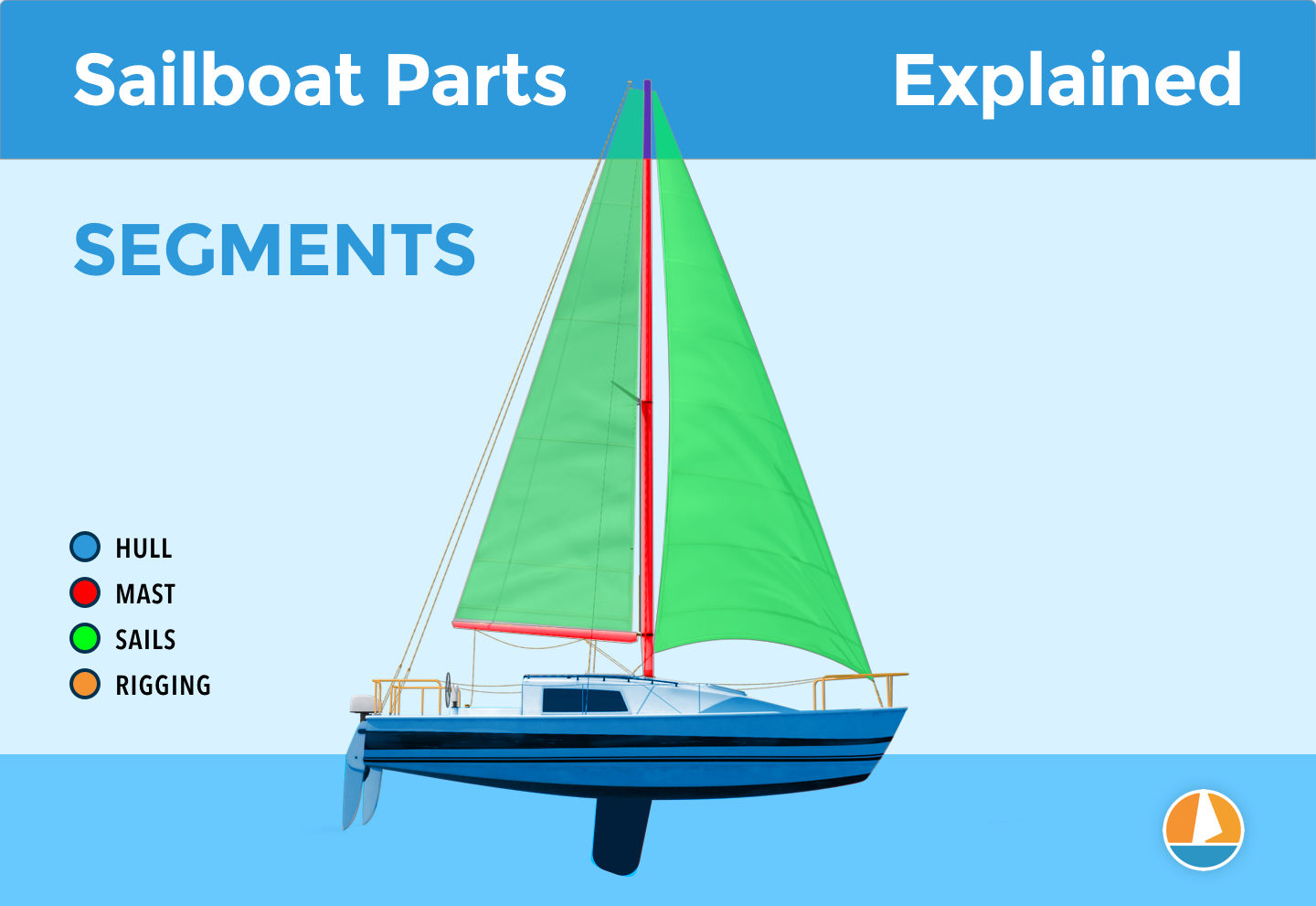
The hull is what most people would consider 'the boat'. It's the part that provides buoyancy and carries everything else: sails, masts, rigging, and so on. Without the hull, there would be no boat. The hull can be divided into different parts: deck, keel, cabin, waterline, bilge, bow, stern, rudder, and many more.
I'll show you those specific parts later on. First, let's move on to the mast.
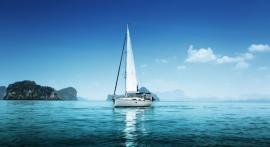
Sailboats Explained
The mast is the long, standing pole holding the sails. It is typically placed just off-center of a sailboat (a little bit to the front) and gives the sailboat its characteristic shape. The mast is crucial for any sailboat: without a mast, any sailboat would become just a regular boat.
I think this segment speaks mostly for itself. Most modern sailboats you see will have two sails up, but they can carry a variety of other specialty sails. And there are all kinds of sail plans out there, which determine the amount and shape of sails that are used.
The Rigging
This is probably the most complex category of all of them.
Rigging is the means with which the sails are attached to the mast. The rigging consists of all kinds of lines, cables, spars, and hardware. It's the segment with the most different parts.
The most important parts
If you learn anything from this article, here are the most important parts of any sailboat. You will find all of these parts in some shape or form on almost any sailboat.
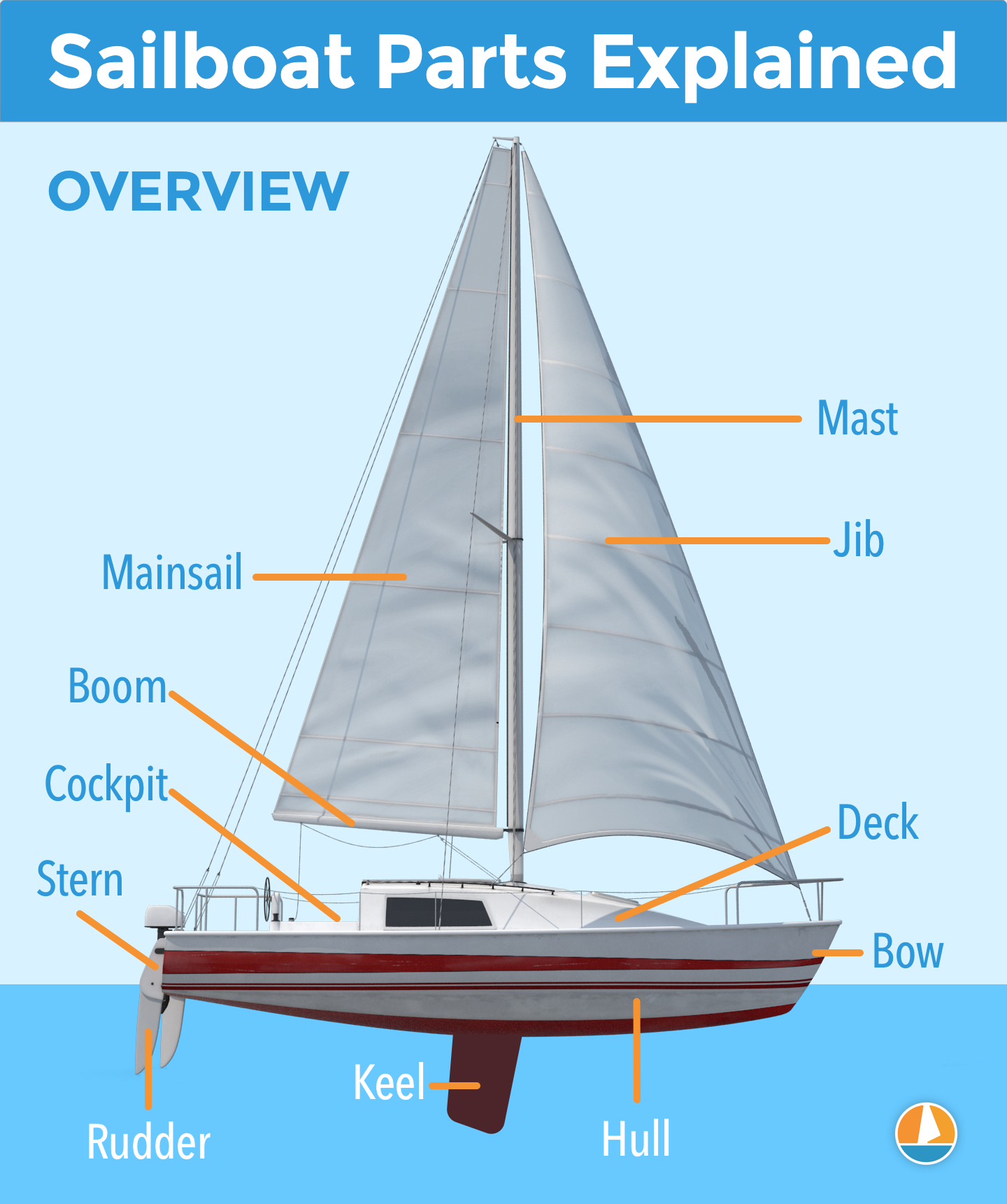
Okay, we now have a good starting point and a good basic understanding of the different sailboat parts. It's time for the good stuff. We're going to dive into each segment in detail.
Below, I'll go over them one by one, pointing out its different parts on a diagram, listing them with a brief explanation, and showing you examples as well.
After reading this article, you'll recognize every single sailboat part and know them by name. And if you forget one, you're free to look it up in this guide.
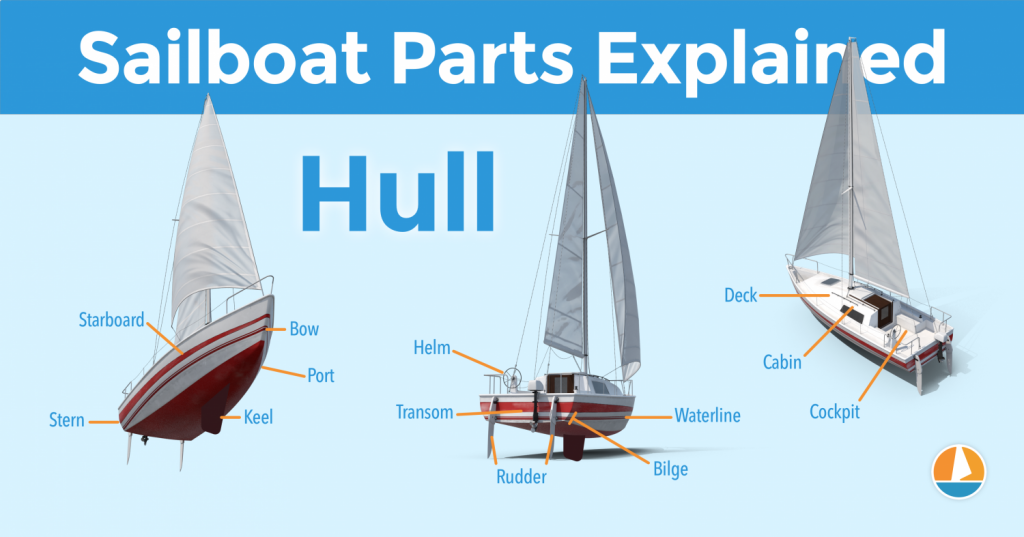
On this page:
The hull is the heart of the boat. It's what carries everything: the mast, the sails, the rigging, the passengers. The hull is what provides the sailboat with its buoyancy, allowing it to stay afloat.
Sailboats mostly use displacement hulls, which is a shape that displaces water when moving through it. They are generally very round and use buoyancy to support its own weight. These two characteristics make sure it is a smooth ride.
There are different hull shapes that work and handle differently. If you want to learn more about them, here's the Illustrated Guide to Boat Hull Types (with 11 Examples ). But for now, all we need to know is that the hull is the rounded, floating part of any sailboat.
Instead of simply calling the different sides of a hull front, back, left and right , we use different names in sailing. Let's take a look at them.
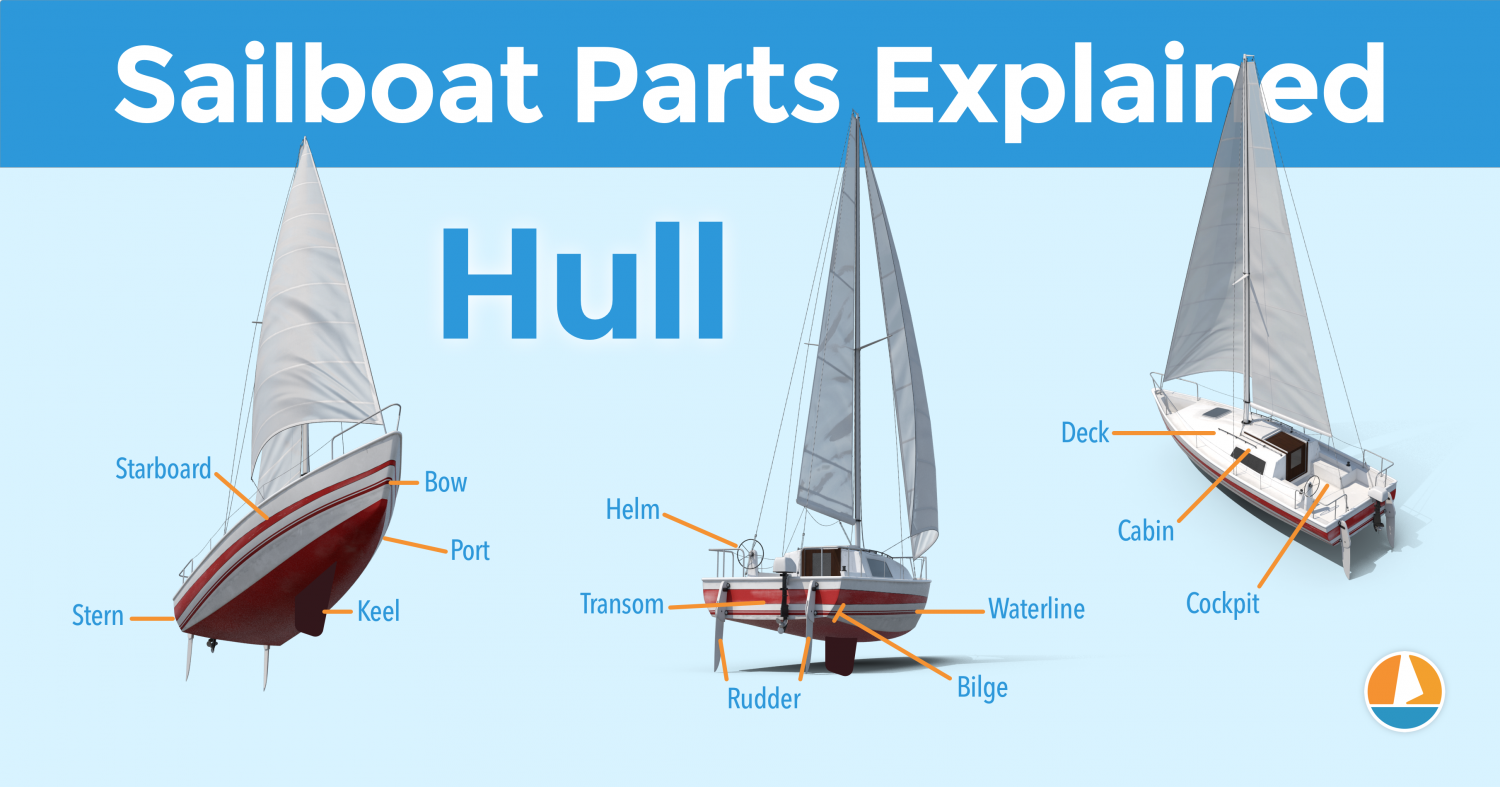
The bow is the front part of the hull. It's simply the nautical word for 'front'. It's the pointy bit that cuts through the water. The shape of the bow determines partially how the boat handles.
The stern is the back part of the hull. It's simply the nautical word for 'back'. The shape of the stern partially determines the stability and speed of the boat. With motorboats, the stern lies deep inside the water, and the hull is flatter aft. Aft also means back. This allows it to plane, increasing the hull speed. For sailboats, stability is much more important, so the hull is rounded throughout, increasing its buoyancy and hydrodynamic properties.
The transom is the backplate of the boat's hull. It's the most aft (rear) part of the boat.
Port is the left side of a sailboat.
Starboard is the right side of a sailboat
The bilges are the part where the bottom and the sides of the hull meet. On sailboats, these are typically very round, which helps with hydrodynamics. On powerboats, they tend to have an angle.
The waterline is the point where the boat's hull meets the water. Generally, boat owners paint the waterline and use antifouling paint below it, to protect it from marine growth.
The deck is the top part of the boat's hull. In a way, it's the cap of the boat, and it holds the deck hardware and rigging.
Displacement hulls are very round and smooth, which makes them very efficient and comfortable. But it also makes them very easy to capsize: think of a canoe, for example.
The keel is a large fin that offsets the tendency to capsize by providing counterbalance. Typically, the keel carries ballast in the tip, creating a counterweight to the wind's force on the sails.
The rudder is the horizontal plate at the back of the boat that is used to steer by setting a course and maintaining it. It is connected to the helm or tiller.
Tiller or Helm
- The helm is simply the nautical term for the wheel.
- The tiller is simply the nautical term for the steering stick.
The tiller or helm is attached to the rudder and is used to steer the boat. Most smaller sailboats (below 30') have a tiller, most larger sailboats use a helm. Large ocean-going vessels tend to have two helms.
The cockpit is the recessed part in the deck where the helmsman sits or stands. It tends to have some benches. It houses the outside navigation and systems interfaces, like the compass, chartplotter, and so on. It also houses the mainsheet traveler and winches for the jib. Most boats are set up so that the entire vessel can be operated from the cockpit (hence the name). More on those different parts later.
Most larger boats have some sort of roofed part, which is called the cabin. The cabin is used as a shelter, and on cruising sailboats you'll find the galley for cooking, a bed, bath room, and so on.
The mast is the pole on a sailboat that holds the sails. Sailboats can have one or multiple masts, depending on the mast configuration. Most sailboats have only one or two masts. Three masts or more is less common.
The boom is the horizontal pole on the mast, that holds the mainsail in place.
The sails seem simple, but actually consist of many moving parts. The parts I list below work for most modern sailboats - I mean 90% of them. However, there are all sorts of specialty sails that are not included here, to keep things concise.

The mainsail is the largest sail on the largest mast. Most sailboats use a sloop rigging (just one mast with one bermuda mainsail). In that case, the main is easy to recognize. With other rig types, it gets more difficult, since there can be multiple tall masts and large sails.
If you want to take a look at the different sail plans and rig types that are out there, I suggest reading my previous guide on how to recognize any sailboat here (opens in new tab).
Sail sides:
- Leech - Leech is the name for the back side of the sail, running from the top to the bottom.
- Luff - Luff is the name for the front side of the sail, running from the top to the bottom.
- Foot - Foot is the name for the lower side of the sail, where it meets the boom.
Sail corners:
- Clew - The clew is the lower aft (back) corner of the mainsail, where the leech is connected to the foot. The clew is attached to the boom.
- Tack - The tack is the lower front corner of the mainsail
- Head - The head is the top corner of the mainsail
Battens are horizontal sail reinforcers that flatten and stiffen the sail.
Telltales are small strings that show you whether your sail trim is correct. You'll find telltales on both your jib and mainsail.
The jib is the standard sized headsail on a Bermuda Sloop rig (which is the sail plan most modern sailboats use).
As I mentioned: there are all kinds, types, and shapes of sails. For an overview of the most common sail types, check out my Guide on Sail Types here (with photos).
The rigging is what is used to attach your sails and mast to your boat. Rigging, in other words, mostly consists of all kinds of lines. Lines are just another word for ropes. Come to think of it, sailors really find all kinds of ways to complicate the word rope ...
Two types of rigging
There are two types of rigging: running and standing rigging. The difference between the two is very simple.
- The running rigging is the rigging on a sailboat that's used to operate the sails. For example, the halyard, which is used to lower and heave the mainsail.
- The standing rigging is the rigging that is used to support the mast and sail plan.
Standing Rigging
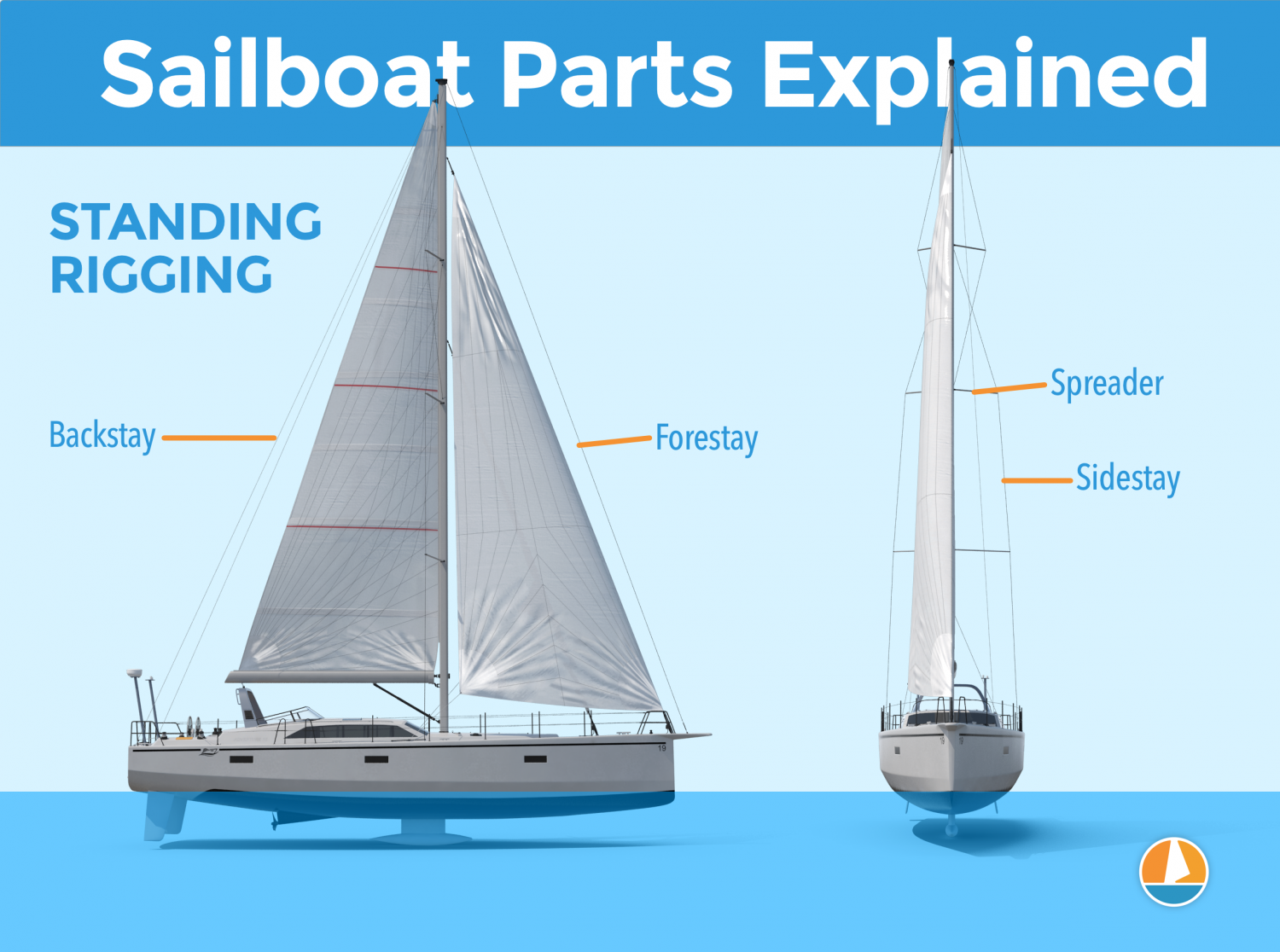
Here are the different parts that belong to the standing rigging:
- Forestay or Headstay - Line or cable that supports the mast and is attached to the bow of the boat. This is often a steel cable.
- Backstay - Line or cable that supports the mast and is attached to the stern of the boat. This is often a steel cable.
- Sidestay or Shroud - Line or cable that supports the mast from the sides of the boat. Most sailboats use at least two sidestays (one on each side).
- Spreader - The sidestays are spaced to steer clear from the mast using spreaders.
Running Rigging: different words for rope
Ropes play a big part in sailing, and especially in control over the sails. In sailboat jargon, we call ropes 'lines'. But there are some lines with a specific function that have a different name. I think this makes it easier to communicate with your crew: you don't have to define which line you mean. Instead, you simply shout 'mainsheet!'. Yeah, that works.
Running rigging consists of the lines, sheets, and hardware that are used to control, raise, lower, shape and manipulate the sails on a sailboat. Rigging varies for different rig types, but since most sailboats are use a sloop rig, nearly all sailboats use the following running rigging:
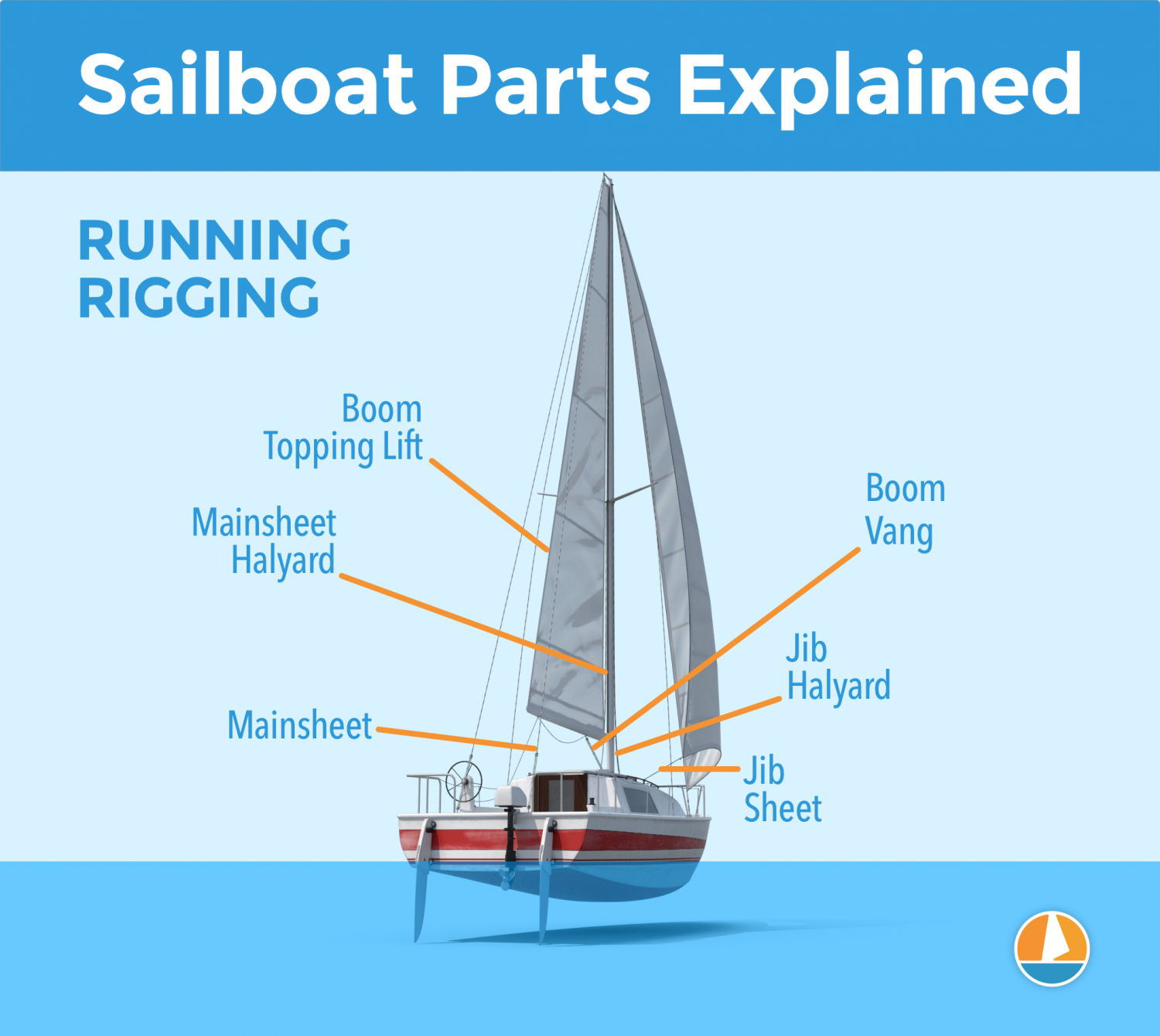
- Halyards -'Halyard' is simply the nautical name for lines or ropes that are used to raise and lower the mainsail. The halyard is attached to the top of the mainsail sheet, or the gaffer, which is a top spar that attaches to the mainsail. You'll find halyards on both the mainsail and jib.
- Sheets - 'Sheet' is simply the nautical term for lines or ropes that are used to set the angle of the sail.
- Mainsheet - The line, or sheet, that is used to set the angle of the mainsail. The mainsheet is attached to the Mainsheet traveler. More on that under hardware.
- Jib Sheet - The jib mostly comes with two sheets: one on each side of the mast. This prevents you from having to loosen your sheet, throwing it around the other side of the mast, and tightening it. The jib sheets are often controlled using winches (more on that under hardware).
- Cleats are small on-deck hooks that can be used to tie down sheets and lines after trimming them.
- Reefing lines - Lines that run through the mainsail, used to put a reef in the main.
- The Boom Topping Lift is a line that is attached to the aft (back) end of the boom and runs to the top of the mast. It supports the boom whenever you take down the mainsail.
- The Boom Vang is a line that places downward tension on the boom.
There are some more tensioning lines, but I'll leave them for now. I could probably do an entire guide on the different sheets on a sailboat. Who knows, perhaps I'll write it.
This is a new segment, that I didn't mention before. It's a bit of an odd duck, so I threw all sorts of stuff into this category. But they are just as important as all the other parts. Your hardware consists of cleats, winches, traveler and so on. If you don't know what all of this means, no worries: neither did I. Below, you'll find a complete overview of the different parts.
Deck Hardware
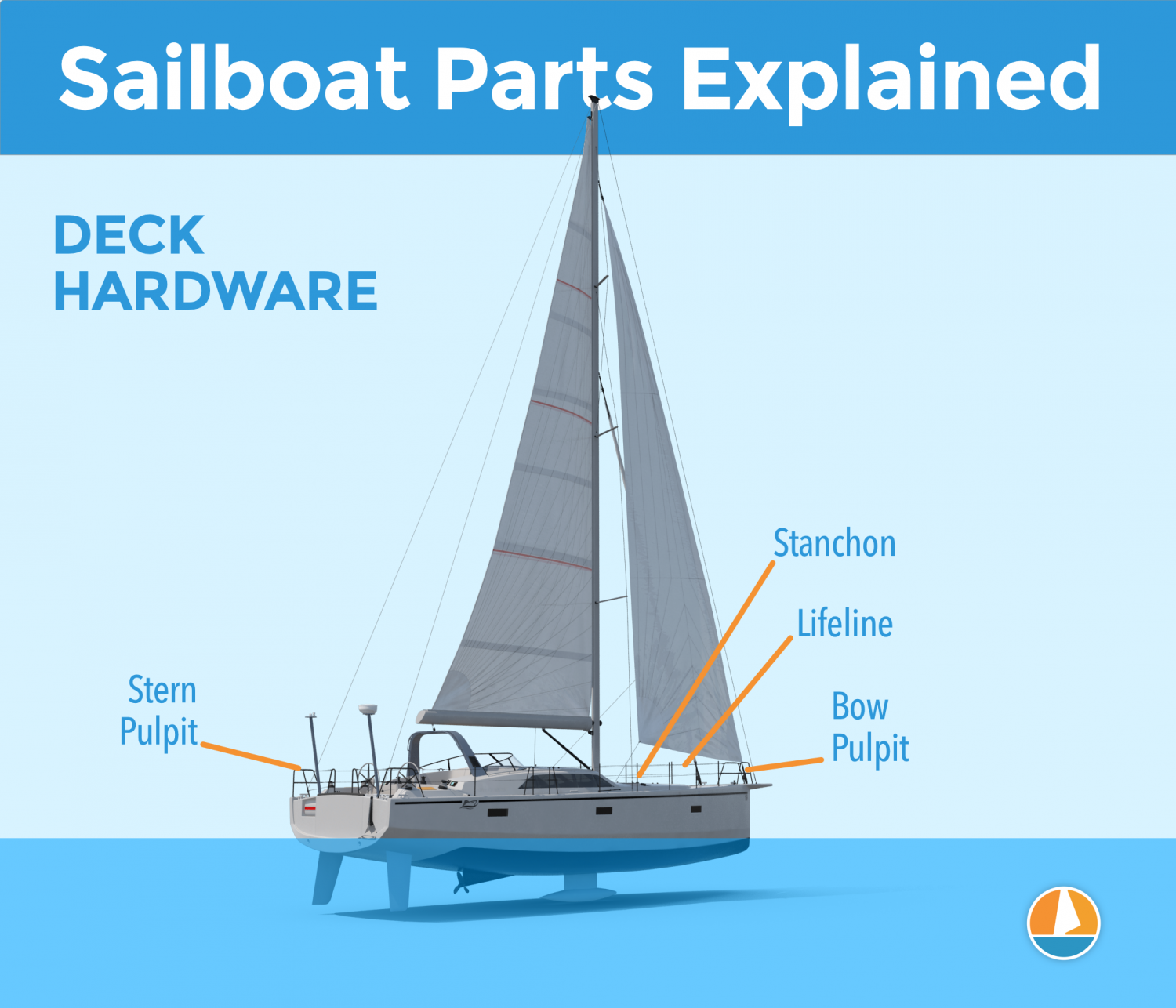
Just a brief mention of the different deck hardware parts:
- Pulpits are fenced platforms on the sailboat's stern and bow, which is why they are called the bow pulpit and stern pulpit here. They typically have a solid steel framing for safety.
- Stanchons are the standing poles supporting the lifeline , which combined for a sort of fencing around the sailboat's deck. On most sailboats, steel and steel cables are used for the stanchons and lifelines.
Mainsheet Traveler
The mainsheet traveler is a rail in the cockpit that is used to control the mainsheet. It helps to lock the mainsheet in place, fixing the mainsails angle to the wind.
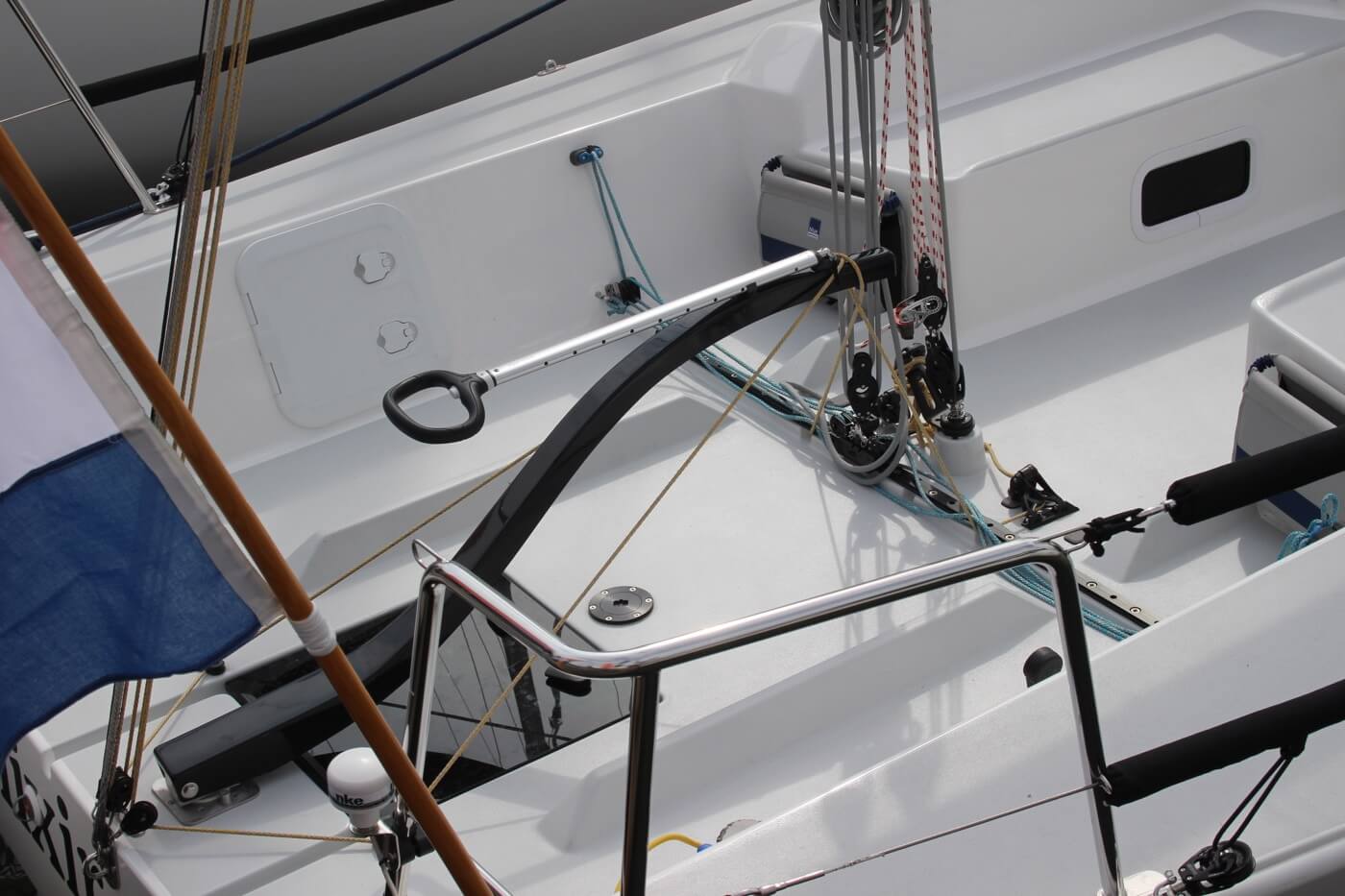
If you're interested in learning more about how to use the mainsheet traveler, Matej has written a great list of tips for using your mainsheet traveler the right way . It's a good starting point for beginners.
Winches are mechanical or electronic spools that are used to easily trim lines and sheets. Most sailboats use winches to control the jib sheets. Modern large sailing yachts use electronic winches for nearly all lines. This makes it incredibly easy to trim your lines.
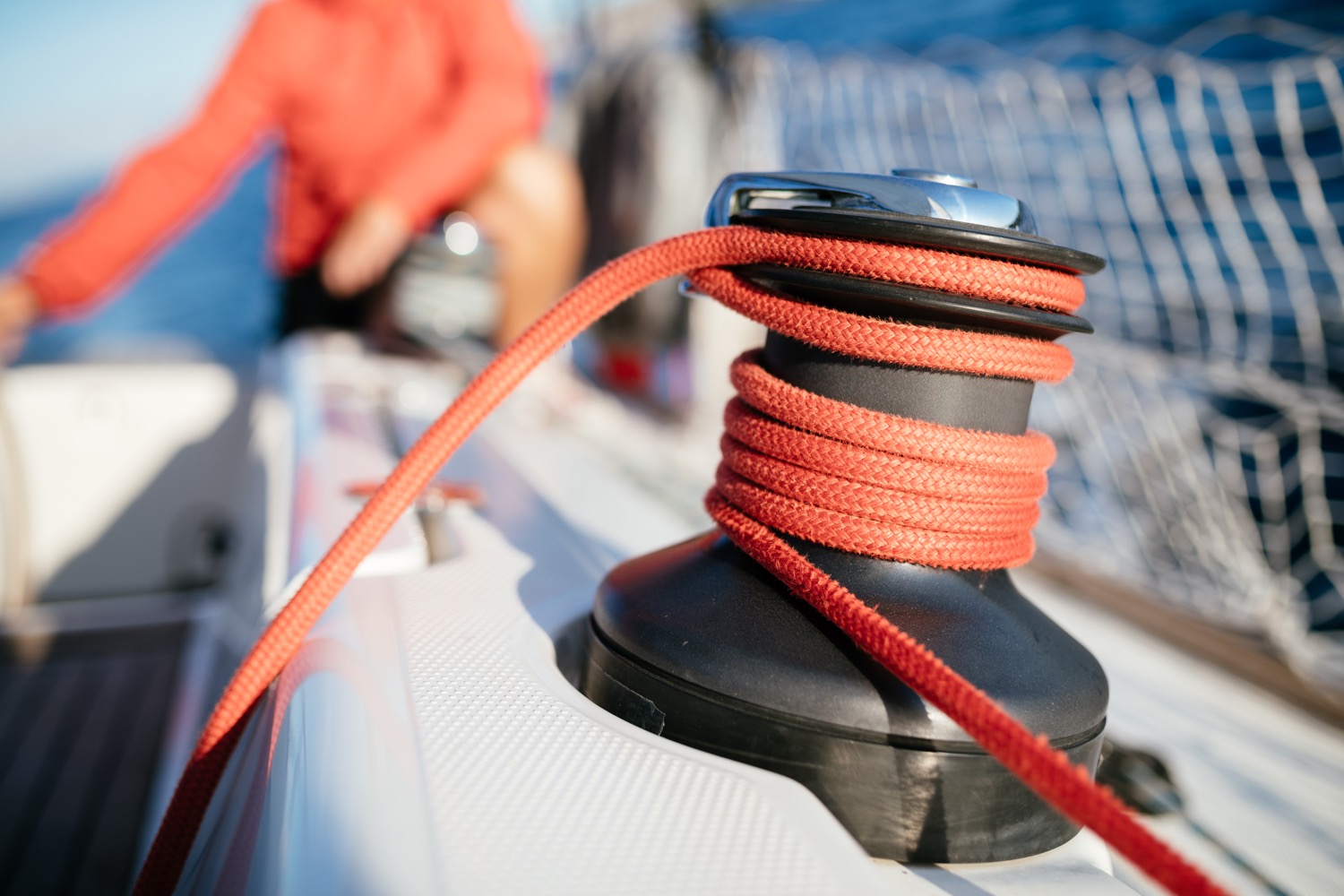
You'll find the compass typically in the cockpit. It's the most old-skool navigation tool out there, but I'm convinced it's also one of the most reliable. In any way, it definitely is the most solid backup navigator you can get for the money.
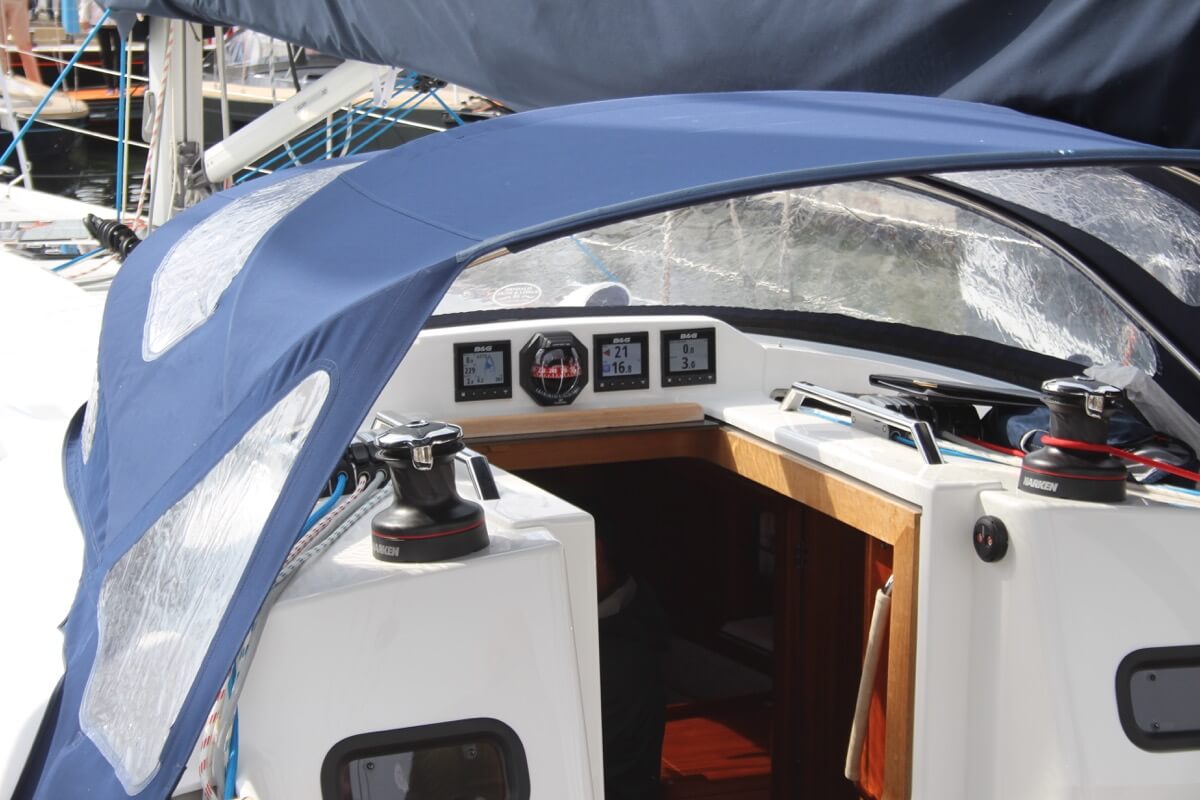
Want to learn how to use a compass quickly and reliably? It's easy. Just read my step-by-step beginner guide on How To Use a Compass (opens in new tab .
Chartplotter
Most sailboats nowadays use, besides a compass and a map, a chartplotter. Chartplotters are GPS devices that show a map and a course. It's very similar to your normal car navigation.
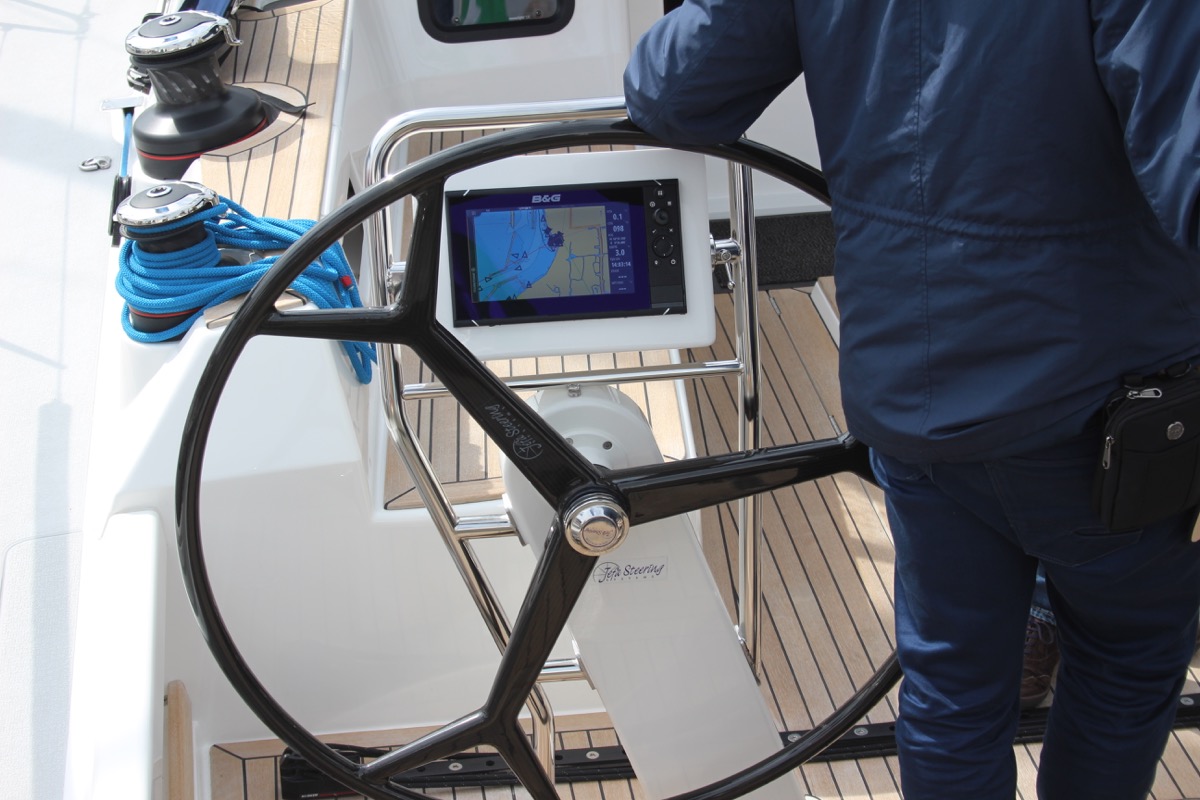
Outboard motor
Most sailboats have some sort of motor to help out when there's just the slightest breeze. These engines aren't very big or powerful, and most sailboats up to 32' use an outboard motor. You'll find these at the back of the boat.

Most sailboats carry 1 - 3 anchors: one bow anchor (the main one) and two stern anchors. The last two are optional and are mostly used by bluewater cruisers.
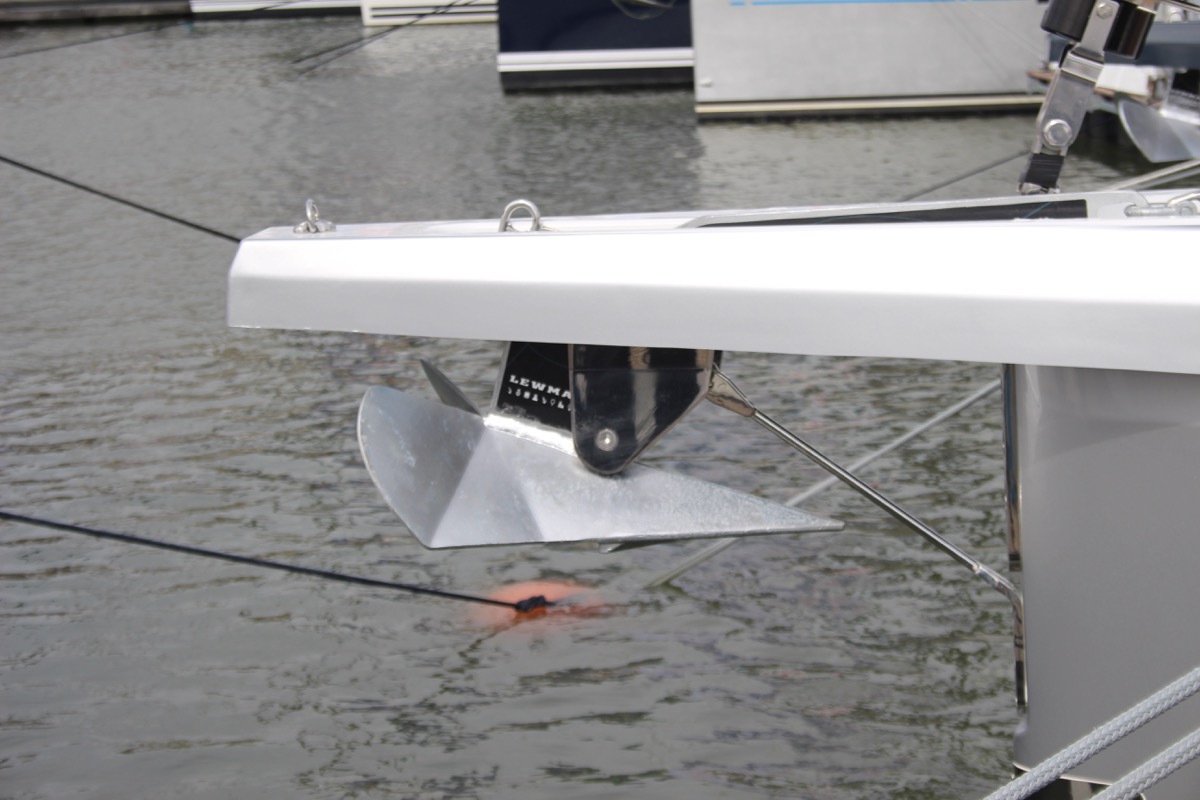
I hope this was helpful, and that you've gained a good understanding of the different parts involved in sailing. I wanted to write a good walk-through instead of overwhelming you with lists and lists of nautical terms. I hope I've succeeded. If so, I appreciate any comments and tips below.
I've tried to be as comprehensive as possible, without getting into the real nitty gritty. That would make for a gigantic article. However, if you feel I've left something out that really should be in here, please let me know in the comments below, so I can update the article.
I own a small 20 foot yacht called a Red witch made locally back in the 70s here in Western Australia i found your article great and enjoyed reading it i know it will be a great help for me in my future leaning to sail regards John.
David Gardner
İ think this is a good explanation of the difference between a ”rope” and a ”line”:
Rope is unemployed cordage. In other words, when it is in a coil and has not been assigned a job, it is just a rope.
On the other hand, when you prepare a rope for a specific task, it becomes employed and is a line. The line is labeled by the job it performs; for example, anchor line, dock line, fender line, etc.
Hey Mr. Buckles
I am taking on new crew to race with me on my Flying Scot (19ft dingy). I find your Sailboat Parts Explained to be clear and concise. I believe it will help my new crew learn the language that we use on the boat quickly without being overwhelmed.
PS: my grandparents were from Friesland and emigrated to America.
Thank you Shawn for the well written, clear and easy to digest introductory article. Just after reading this first article I feel excited and ready to set sails and go!! LOL!! Cheers! Daniel.
steve Balog
well done, chap
Great intro. However, the overview diagram misidentifies the cockpit location. The cockpit is located aft of the helm. Your diagram points to a location to the fore of the helm.
William Thompson-Ambrose
An excellent introduction to the basic anatomy and function of the sailboat. Anyone who wants to start sailing should consider the above article before stepping aboard! Thank-you
James Huskisson
Thanks for you efforts mate. We’ve all got to start somewhere. Thanks for sharing. Hoping to my first yacht. 25ft Holland. Would love to cross the Bass Strait one day to Tasmania. 👌 Cheers mate
Alan Alexander Percy
thankyou ijust aquired my first sailboat at 66yrs of age its down at pelican point a beautifull place in virginia usa my sailboat is a redwing 30 if you are ever in the area i wouldnt mind your guidance and superior knowledge of how to sail but iam sure your fantastic article will help my sailboat is wings 30 ft
Thanks for quick refresher course. Having sailed in California for 20+ years I now live in Spain where I have to take a spanish exam for a sailboat license. Problem is, it’s only in spanish. So a lot to learn for an old guy like me.
Very comprehensive, thank you
Your article really brought all the pieces together for me today. I have been adventuring my first sailing voyage for 2 months from the Carolinas and am now in Eleuthera waiting on weather to make the Exumas!!! Great job and thanks
Helen Ballard
I’ve at last found something of an adventure to have in sailing, so I’m starting at the basics, I have done a little sailing but need more despite being over 60 life in the old dog etc, thanks for your information 😊
Barbara Scott
I don’t have a sailboat, neither do l plan to literally take to the waters. But for mental exercise, l have decided to take to sailing in my Bermuda sloop, learning what it takes to become a good sailor and run a tight ship, even if it’s just imaginary. Thank you for helping me on my journey to countless adventures and misadventures, just to keep it out of the doldrums! (I’m a 69 year old African American female who have rediscovered why l enjoyed reading The Adventures of Robert Louis Stevenson as well as his captivating description of sea, wind, sailboat,and sailor).
Great article and very good information source for a beginner like me. But I didn’t find out what I had hoped to, which is, what are all those noisy bits of kit on top of the mast? I know the one with the arrow is a weather vane, but the rest? Many thanks, Jay.
Louis Cohen
The main halyard is attached to the head of the mainsail, not the to the mainsheet. In the USA, we say gaff, not gaffer. The gaff often has its own halyard separate from the main halyard.
Other than that it’s a nice article with good diagrams.
A Girl Who Has an Open Sail Dream
Wow! That was a lot of great detail! Thank you, this is going to help me a lot on my project!
Hi, good info, do u know a book that explains all the systems on a candc 27,
Leave a comment
You may also like, guide to understanding sail rig types (with pictures).
There are a lot of different sail rig types and it can be difficult to remember what's what. So I've come up with a system. Let me explain it in this article.
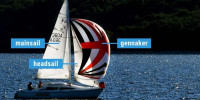
The Ultimate Guide to Sail Types and Rigs (with Pictures)
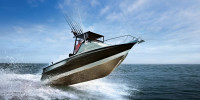
The Illustrated Guide To Boat Hull Types (11 Examples)
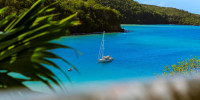
How To Live On a Boat For Free: How I'd Do It

How To Live on a Sailboat: Consider These 5 Things
- Types of Sailboats
- Parts of a Sailboat
- Cruising Boats
- Small Sailboats
- Design Basics
- Sailboats under 30'
- Sailboats 30'-35
- Sailboats 35'-40'
- Sailboats 40'-45'
- Sailboats 45'-50'
- Sailboats 50'-55'
- Sailboats over 55'
- Masts & Spars
- Knots, Bends & Hitches
- The 12v Energy Equation
- Electronics & Instrumentation
- Build Your Own Boat
- Buying a Used Boat
- Choosing Accessories
- Living on a Boat
Sailboat Cruising Tips for Beginners
- Sailing in the Caribbean
- Anchoring Skills
- Sailing Authors & Their Writings
- Mary's Journal
- Nautical Terms
- Cruising Sailboats for Sale
- List your Boat for Sale Here!
- Used Sailing Equipment for Sale
- Sell Your Unwanted Gear
- Sailing eBooks: Download them here!
- Your Sailboats
- Your Sailing Stories
- Your Fishing Stories
- Advertising
- What's New?
- Chartering a Sailboat
- Sailboat Cockpit
What makes for an Efficient Sailboat Cockpit?
Perhaps because sailboat cockpit design doesn't present the same marketing opportunities as the living space below it, it's not unusual to find that cockpit layouts have been compromised in favour of a commodious aft-cabin.
This is borne out by a number of modestly sized boats that accept the disadvantages of a centre-cockpit in favour of a veritable bedroom in the stern where the cockpit should rightly be.
Underway, the cockpit is the centre of activity. Helming, watchkeeping, sail trimming or just plain relaxing - it's all done from here.
Sheets, cleats and jammers should fall readily to hand, and winch handles must be able to operate 'full circle'.
Properly thought out, it will be a satisfying and safe place to be - efficient for sailors and comfortable for our guests.
Keeping the Helmsman & Sheet Handlers Happy
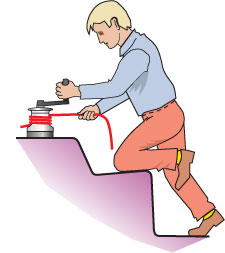
Foremost in the cockpit designer's mind should be the requirements of the helmsman and the sheet handlers.
For a wheel-steered yacht a 'T' shaped cockpit is often the preferred solution, giving the otherwise trapped helmsman room to move around the wheel into the main part of the cockpit.
The cockpit seats of a tiller-steered yacht must accommodate the sweep of the tiller without interference, and the tiller itself should be of a height and shape to avoid the knees of a sitting helmsman.
Sailboat Cockpit Ergonomics and Dimensions
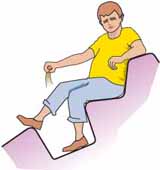
It's not enough for the cockpit to be secure; it must also feel secure. But it won't if the sensation is of being perched upon on it rather than being in it.
Security is largely a function of the depth of the cockpit, over which other factors have a controlling influence:~
- At extreme angles of heel the leeward edge of the sole must remain above the waterline level to enable it to drain;
- The cockpit sole should not be so deep such that it is impossible to see over the coachroof when standing up;
- Although the dimensions of the human body determine the height of the seat above the sole, usually 375mm to 500mm, ideally you'll also be able to see over the coachroof when sitting down.
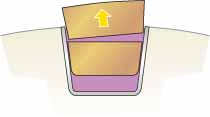
Other features to be found in a good, sea-going sail boat cockpit layout include:~
- Seatbacks that are at least 350mm high and angled such that you can remain sitting upright on the windward side when the boat is heeled;
- Seats wide enough, around 500mm, to provide adequate support under the thighs;
- Seats that are parallel and close enough together to enable seated occupants on the windward side to comfortably brace their feet against the leeward seats when heeled;
- Moderate volume and adequate drainage. For an aft-cockpit boat, the most efficient drainage is through the transom. A couple of 50mm diameter holes here will drain a moderately sized sailboat cockpit inside two minutes;
- A bridgedeck to at least the height of the seats, which not only reduces the volume of the cockpit well but also provides a step-up to the companionway sill;
- The companionway sill should be at least as high as the coaming, thereby preventing a cockpit full of water from finding its way below;
- A main hatch, preferably on the centreline, with moderately angled sides. Washboards in a heavily vee'd hatch only have to float up a short distance before they fall out.
Artwork by Andrew Simpson
A Cockpit Table?
The final embellishment for the perfect sailboat cockpit is a cockpit table, which four people can sit around comfortable.
Many sailboats with wheel steering have a fixed table attached to the pedestal as shown here, but my preference is to keep the cockpit clear when underway, and have a table that folds down against the pedestal.
Tiller steered sailboats usually have a removable cockpit table for use at anchor or in harbour.
Read here the argument for where the sailboat cockpit is best placed - centre or aft?
You might like to take a look at these...
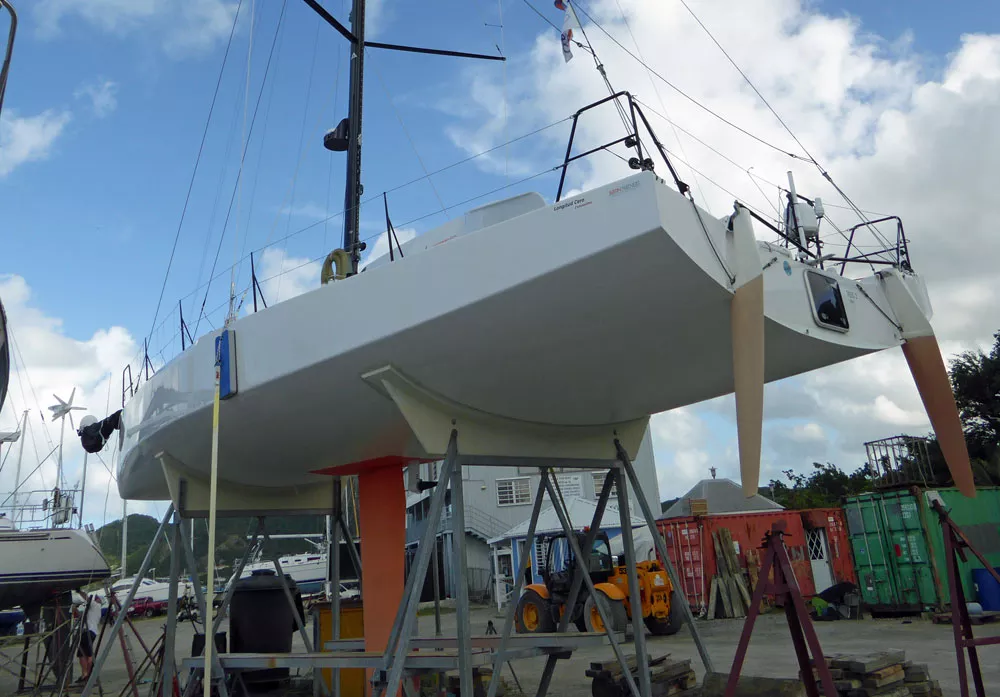
Sailboat Rudders
Illustrated examples of Balanced Sailboat Rudders, Semi-Balanced Rudders, Keel-Hung Rudders, Skeg-Hung Rudders, Spade Rudders, Twin Rudders, and Transom-Hung Rudders
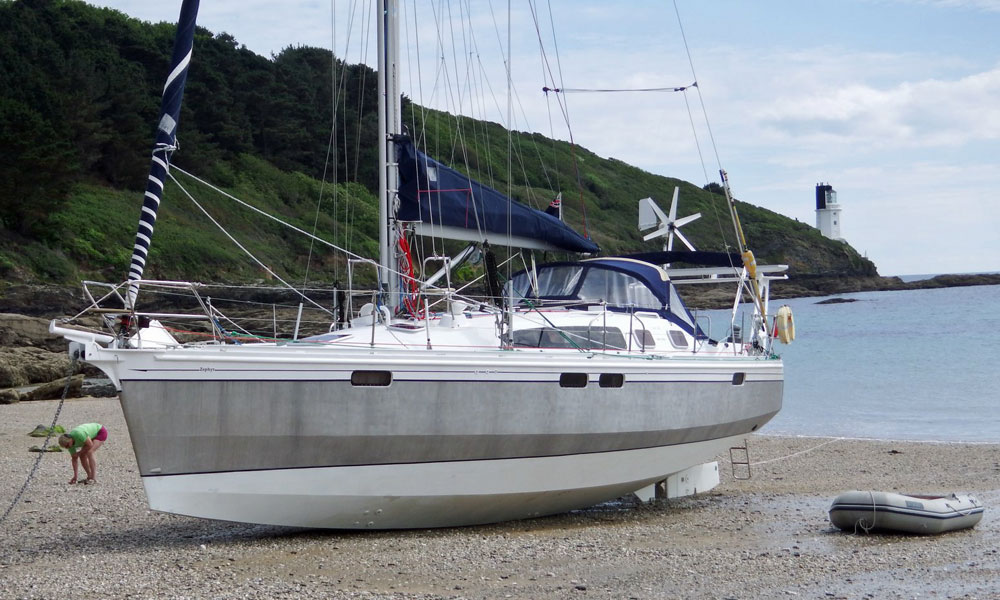
Why Some Sailboat Keels Perform Better To Windward Than Others
But it's not just about windward performance, other types of sailboat keels may suit your sailing area better and reduce your mooring costs; for example
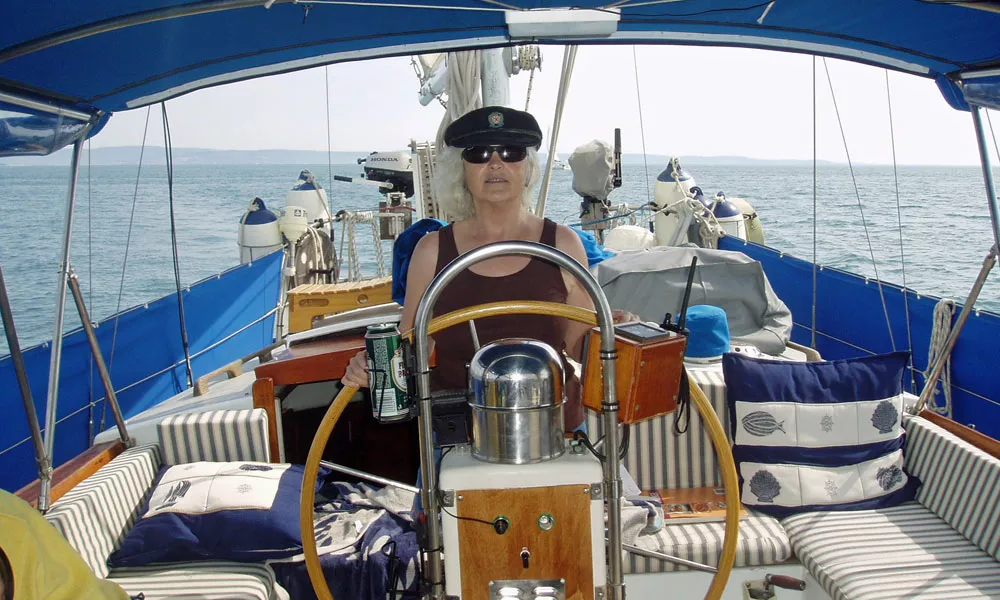
The Case for Sailboat Tillers as an Alternative To Wheel Steering
Just why do so many modern sailboats have wheel steering when sailboat tillers are cheaper, more reliable and convenient? Check out this comparison between wheels and tillers
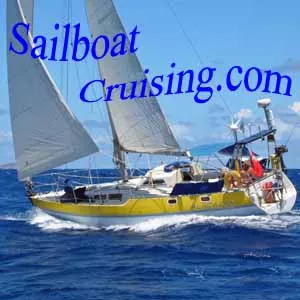
Understanding Hullspeed and the Speed/Length Ratio
For any displacement hull of a given length there's a maximum hullspeed; the longer the waterline length, the quicker the boat. Here's how it works
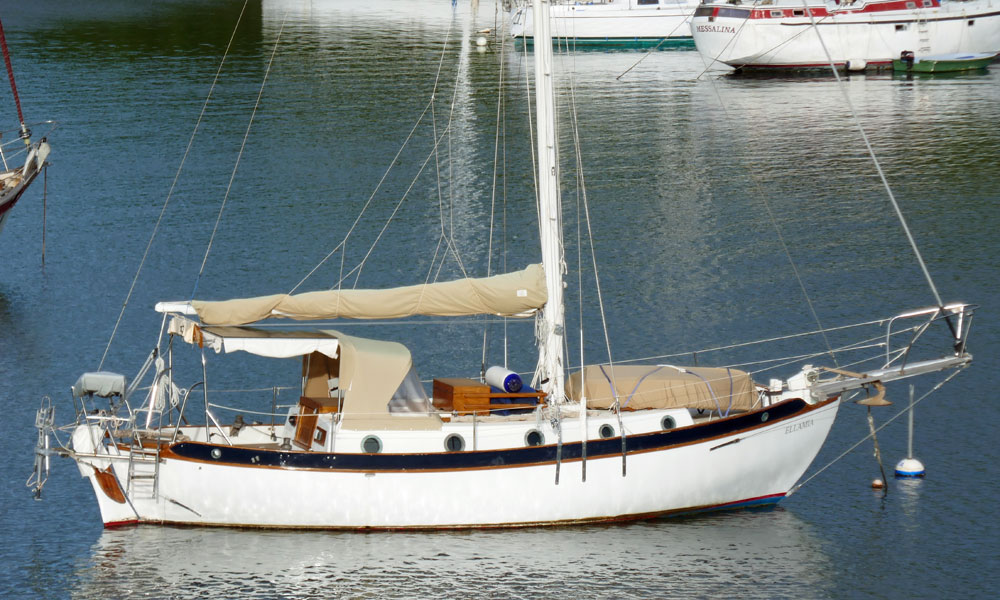
Are Heavy Displacement Hulls the Best Choice for Offshore Cruising?
Increasingly, offshore sailboat skippers are choosing moderate displacement hull forms in preference to heavier vessels when planning for an ocean crossing. And here's why...
Recent Articles
'The Dream', a Hallberg-Rassy 41 for Sale
Nov 07, 24 10:55 AM
The Nicholson 32 Mk10 Sailboat
Nov 02, 24 09:45 AM
Oct 29, 24 12:47 PM
Here's where to:
- Find Used Sailboats for Sale...
- Find Used Sailing Gear for Sale...
- List your Sailboat for Sale...
- List your Used Sailing Gear...
Our eBooks...
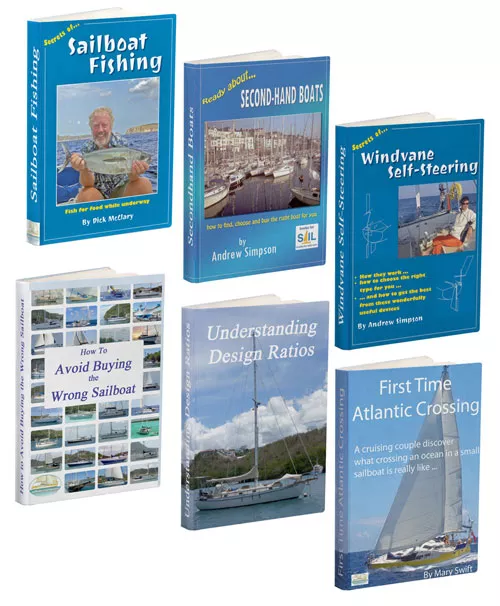
A few of our Most Popular Pages...
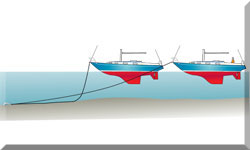
Copyright © 2024 Dick McClary Sailboat-Cruising.com
- BOAT OF THE YEAR
- Newsletters
- Sailboat Reviews
- Boating Safety
- Sails and Rigging
- Maintenance
- Sailing Totem
- Sailor & Galley
- Living Aboard
- Destinations
- Gear & Electronics
- Charter Resources
- Ultimate Boating Giveaway

40 Best Sailboats
- By Cruising World Editors
- Updated: May 24, 2024
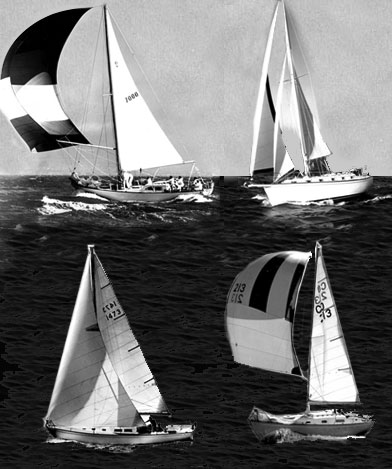
Sailors are certainly passionate about their boats, and if you doubt that bold statement, try posting an article dubbed “ 40 Best Sailboats ” and see what happens.
Barely had the list gone live, when one reader responded, “Where do I begin? So many glaring omissions!” Like scores of others, he listed a number of sailboats and brands that we were too stupid to think of, but unlike some, he did sign off on a somewhat upbeat note: “If it weren’t for the presence of the Bermuda 40 in Cruising World’s list, I wouldn’t even have bothered to vote.”
By vote, he means that he, like hundreds of other readers, took the time to click through to an accompanying page where we asked you to help us reshuffle our alphabetical listing of noteworthy production sailboats so that we could rank them instead by popularity. So we ask you to keep in mind that this list of the best sailboats was created by our readers.
The quest to building this list all began with such a simple question, one that’s probably been posed at one time or another in any bar where sailors meet to raise a glass or two: If you had to pick, what’re the best sailboats ever built?
In no time, a dozen or more from a variety of sailboat manufacturers were on the table and the debate was on. And so, having fun with it, we decided to put the same question to a handful of CW ‘s friends: writers and sailors and designers and builders whose opinions we value. Their favorites poured in and soon an inkling of a list began to take shape. To corral things a bit and avoid going all the way back to Joshua Slocum and his venerable Spray —Hell, to Noah and his infamous Ark —we decided to focus our concentration on production monohull sailboats, which literally opened up the sport to anyone who wanted to get out on the water. And since CW is on the verge or turning 40, we decided that would be a nice round number at which to draw the line and usher in our coming ruby anniversary.
If you enjoy scrolling through this list, which includes all types of sailboats, then perhaps you would also be interested in browsing our list of the Best Cruising Sailboats . Check it out and, of course, feel free to add your favorite boat, too. Here at Cruising World , we like nothing better than talking about boats, and it turns out, so do you.
– LEARN THE NAVIGATION RULES – Know the “Rules of the Road” that govern all boat traffic. Be courteous and never assume other boaters can see you. Safety Tip Provided by the U.S. Coast Guard
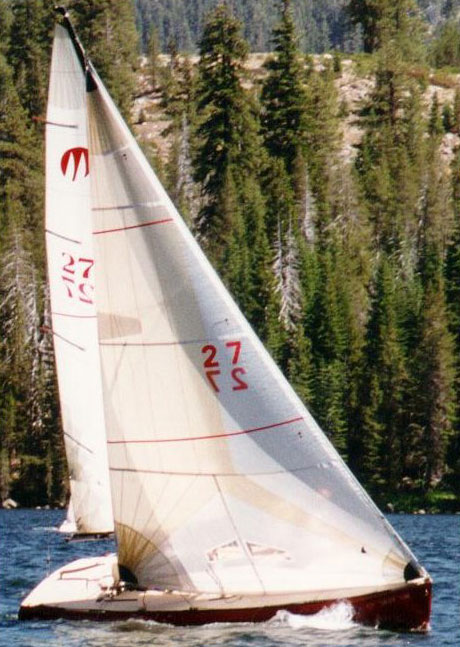
40. Moore 24
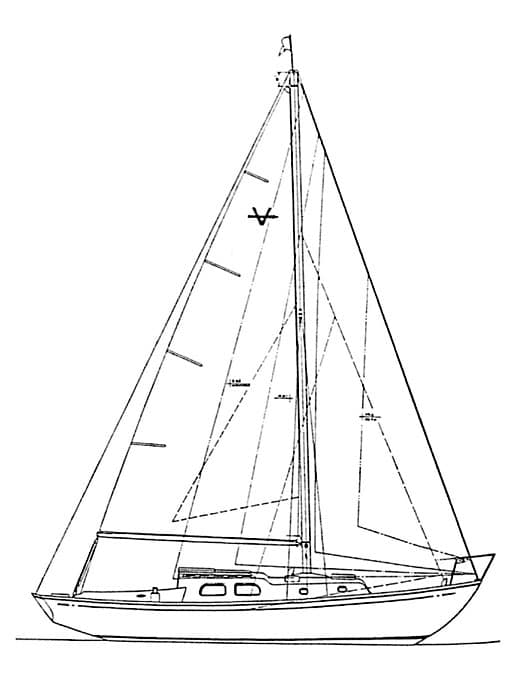
39. Pearson Vanguard
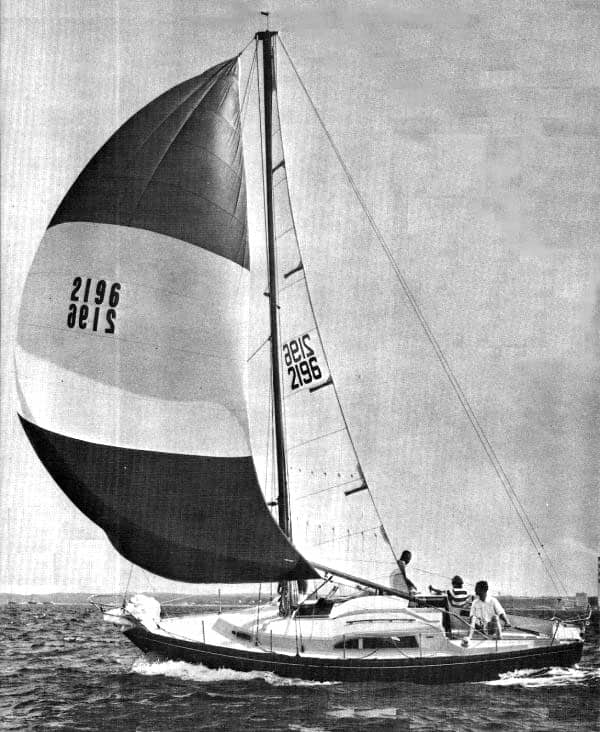
38. Dufour Arpege 30
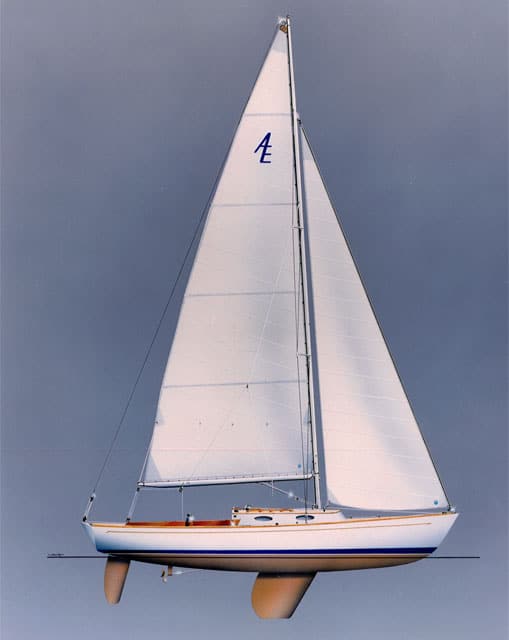
37. Alerion Express 28
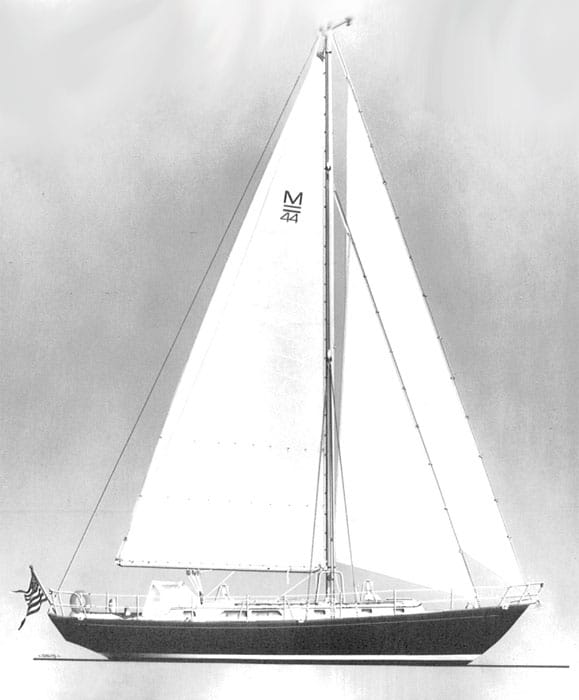
36. Mason 43/44
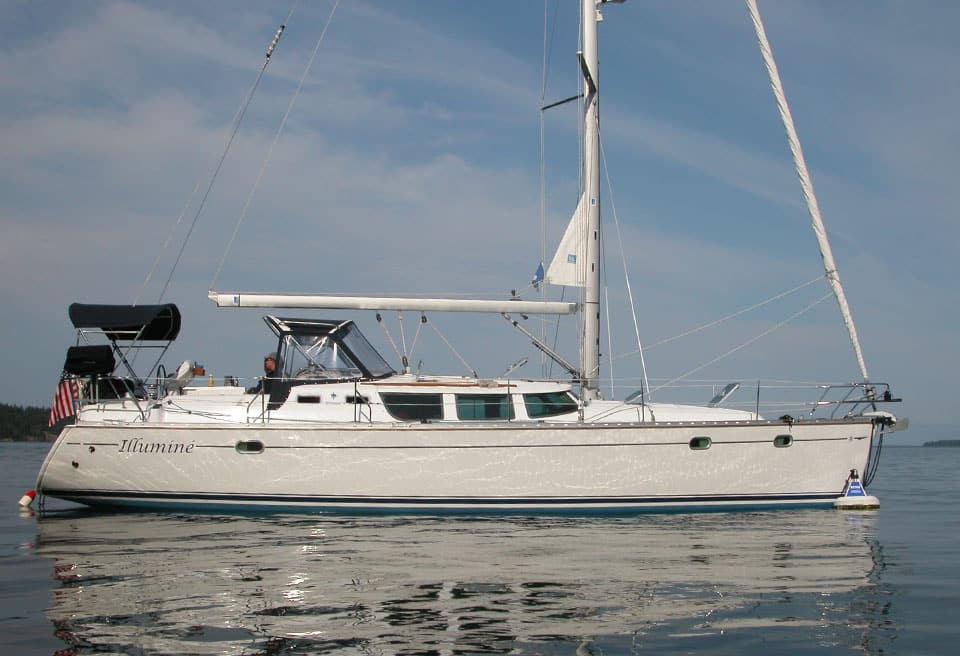

35. Jeanneau Sun Odyssey 43DS
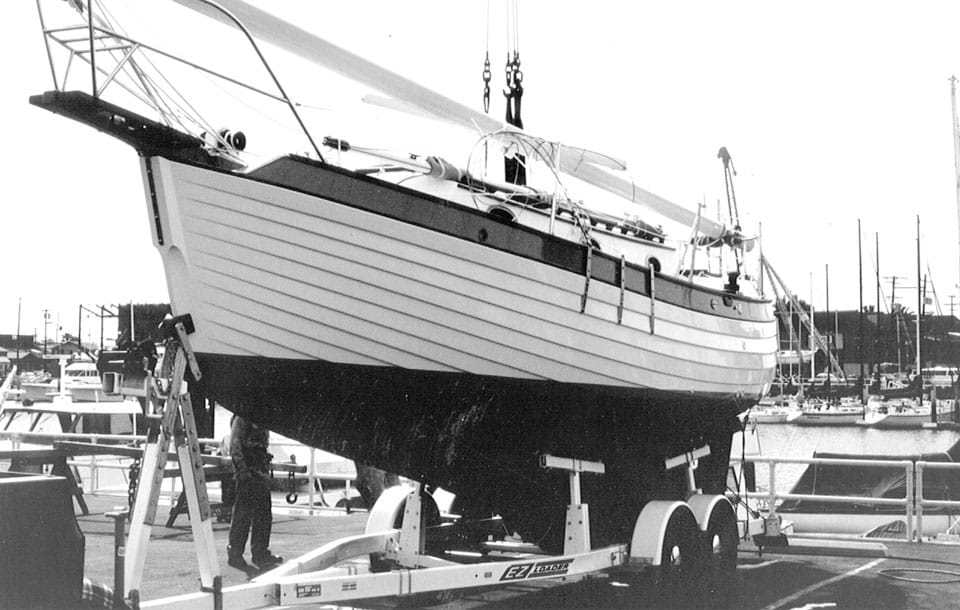
34. Nor’Sea 27
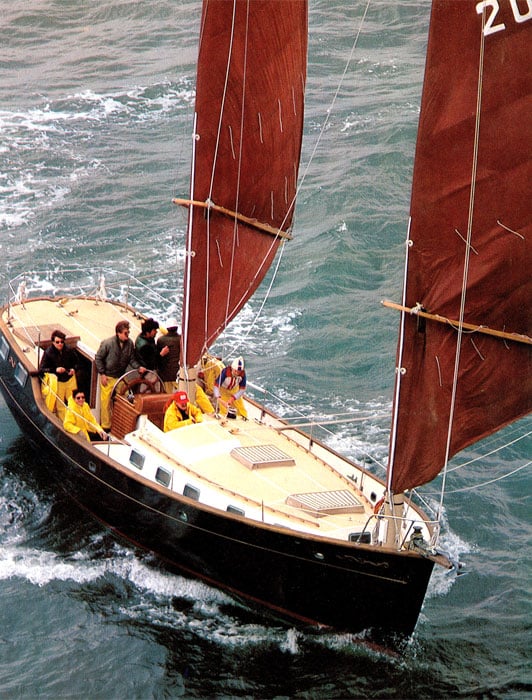
33. Freedom 40
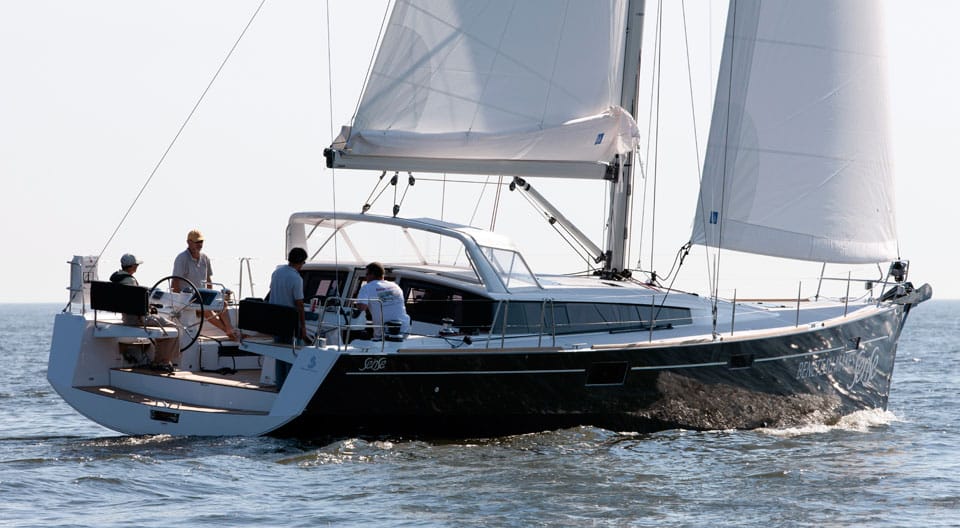
32. Beneteau Sense 50
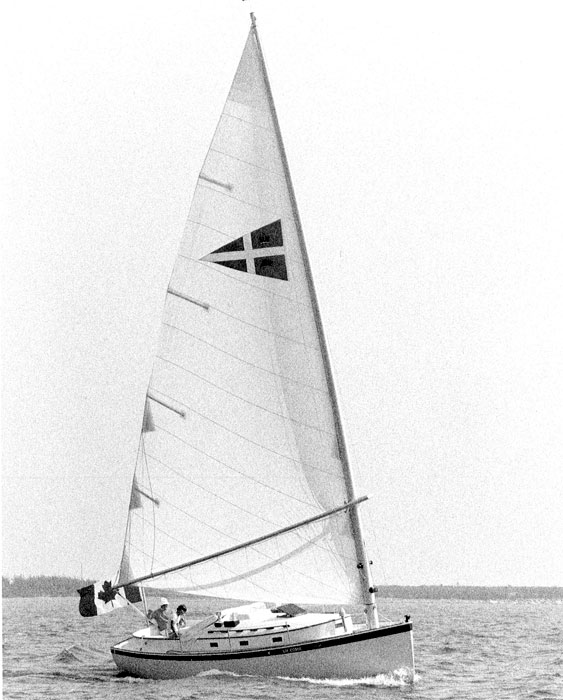
31. Nonsuch 30
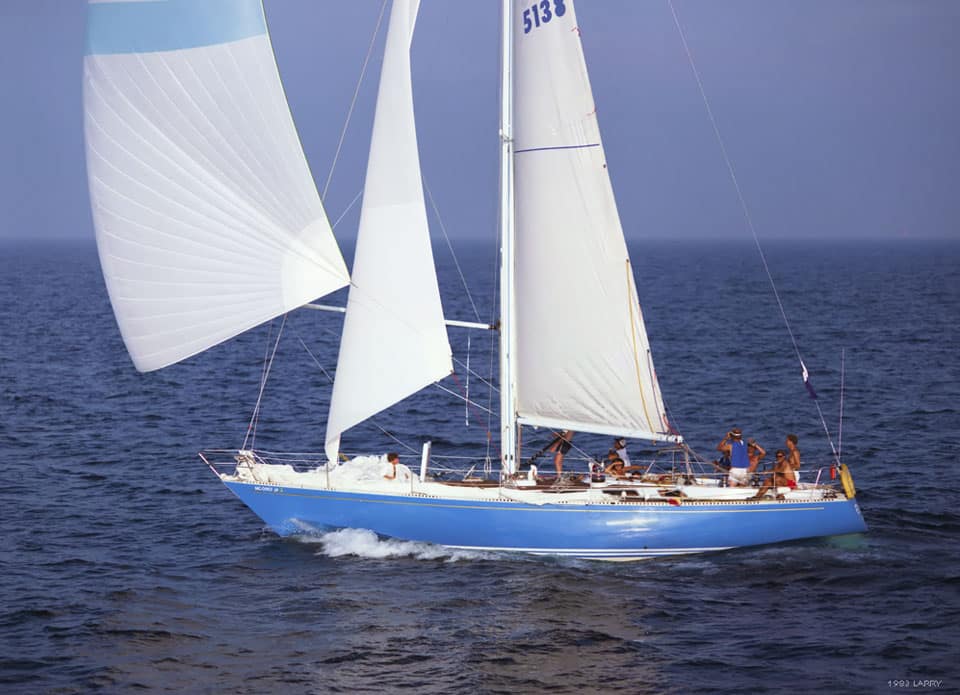
30. Swan 44
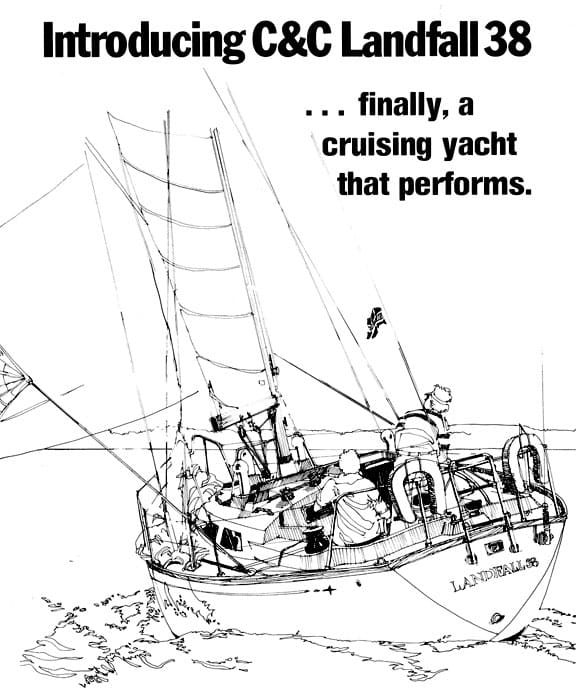
29. C&C Landfall 38
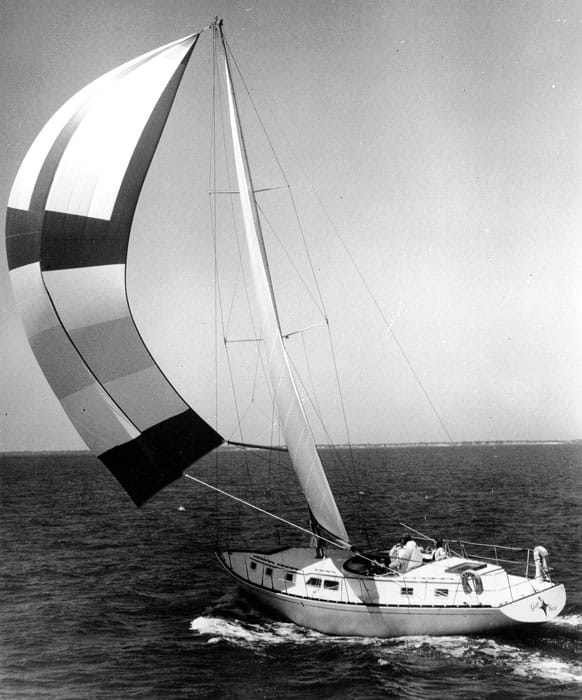
28. Gulfstar 50
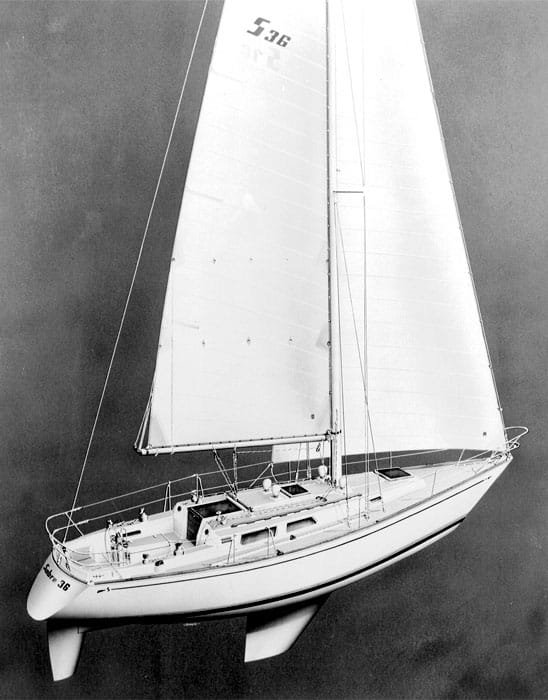
27. Sabre 36
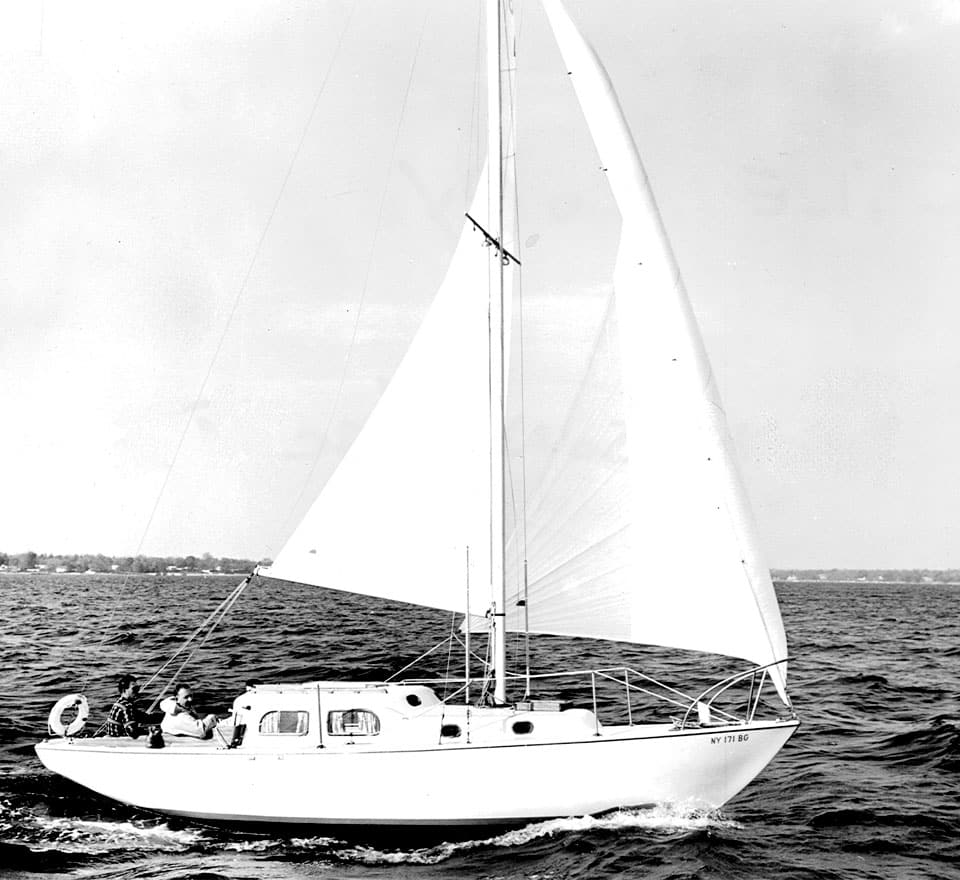
26. Pearson Triton
– CHECK THE FIT – Follow these guidelines to make sure your life jacket looks good, stays comfortable and works when you need it. Safety Tip Provided by the U.S. Coast Guard
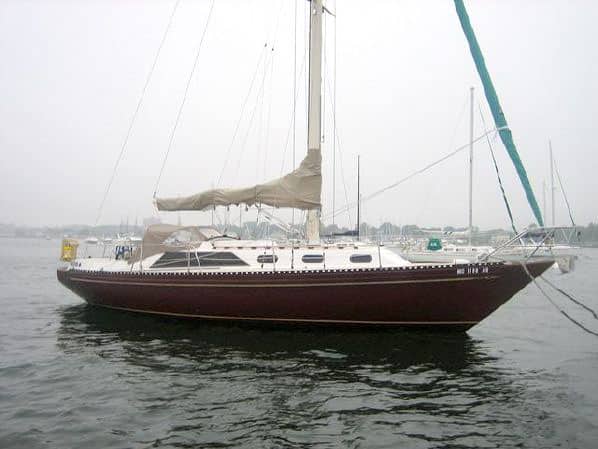
25. Islander 36
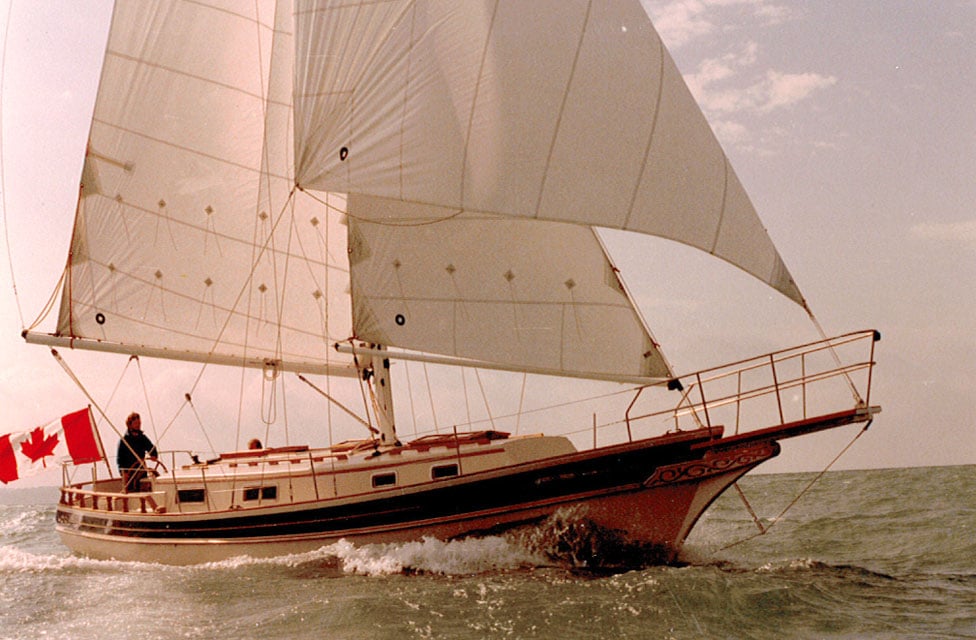
24. Gozzard 36
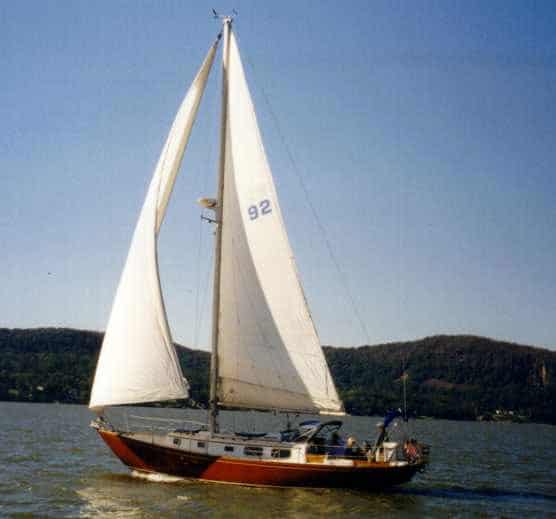
23. Bristol 40
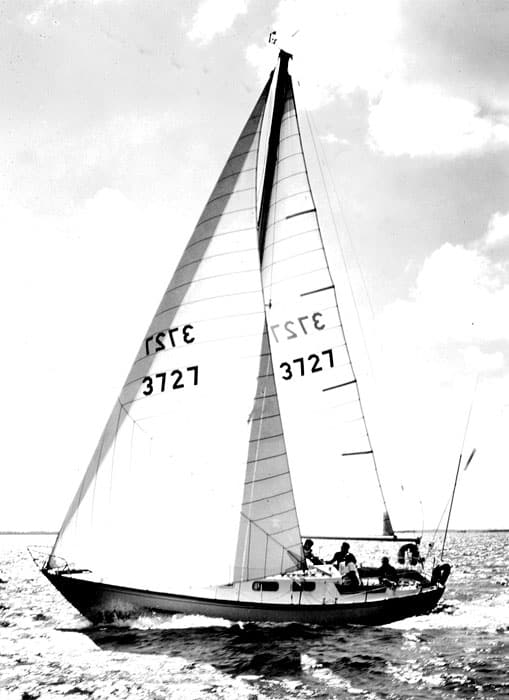
22. Tartan 34
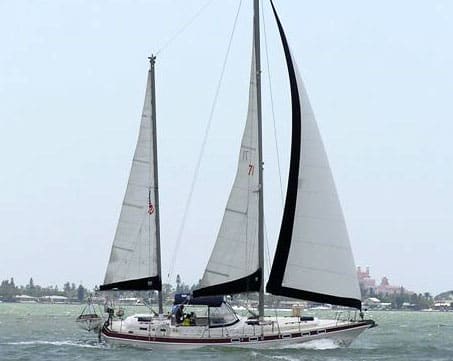
21. Morgan Out Island 41
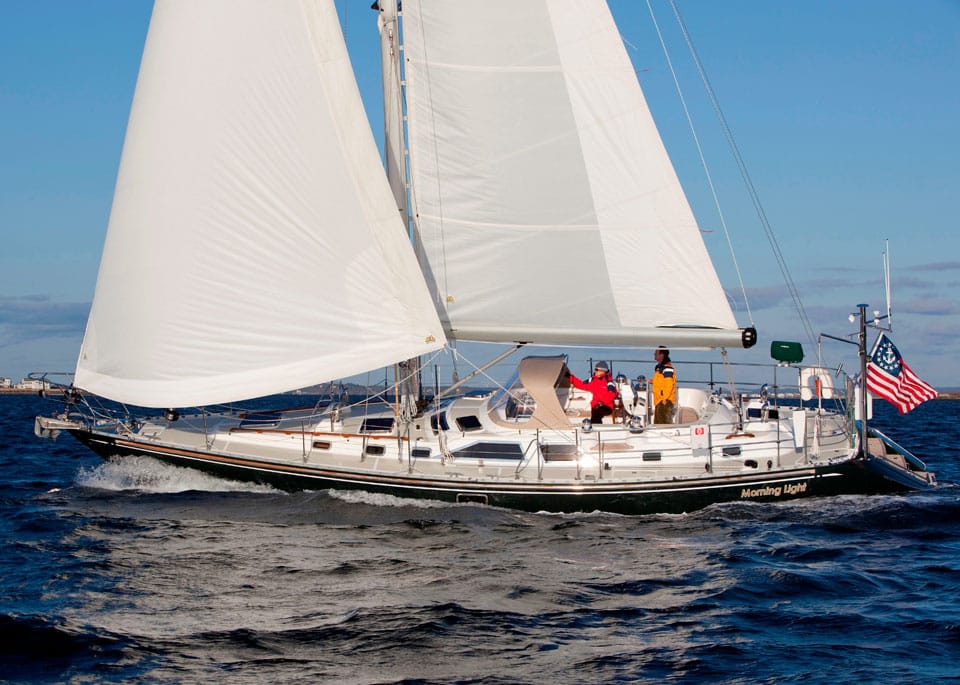
20. Hylas 49
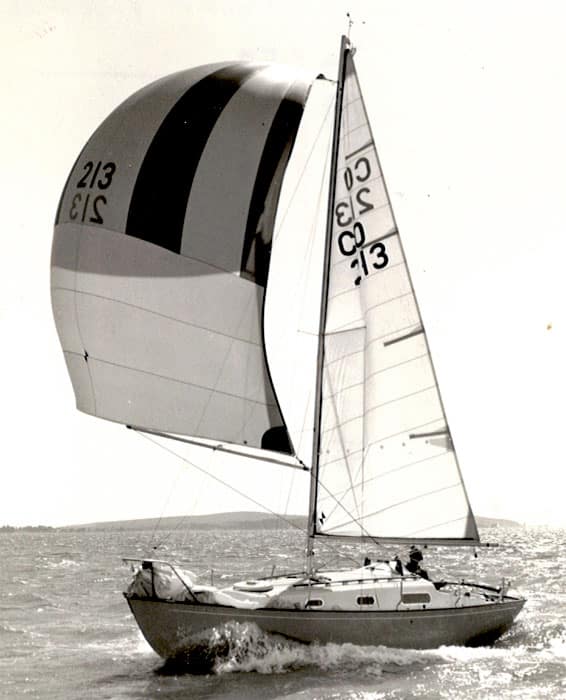
19. Contessa 26
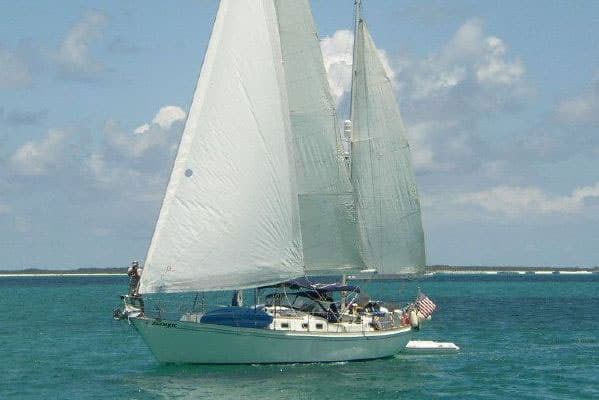
18. Whitby 42
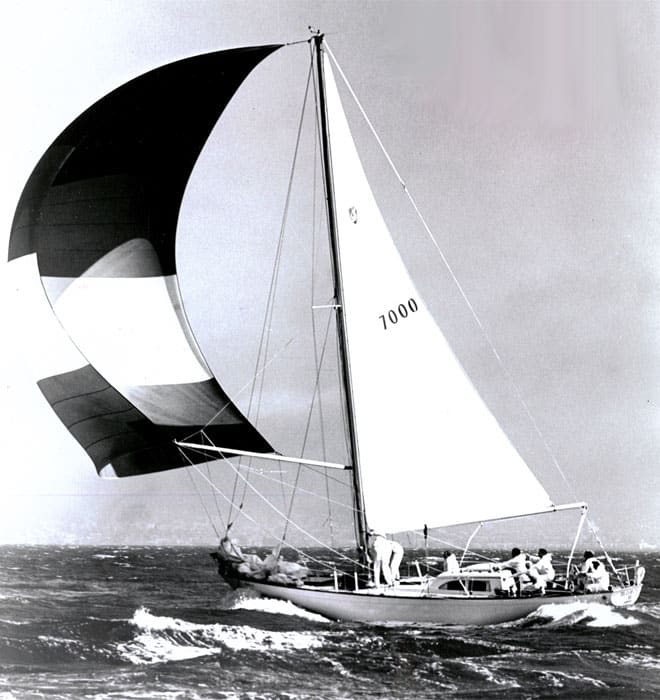
17. Columbia 50
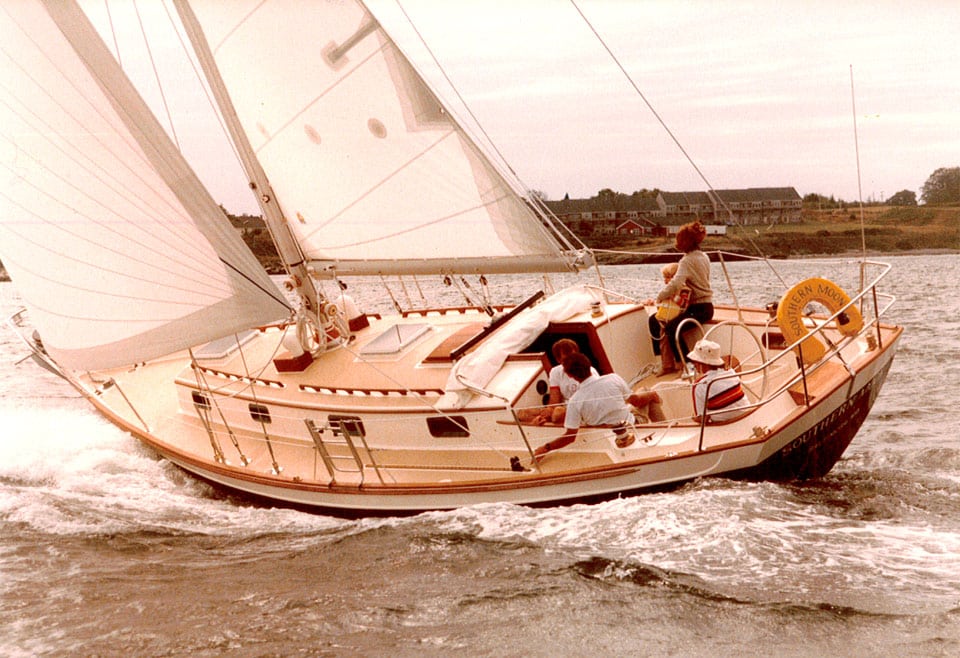
16. Morris 36
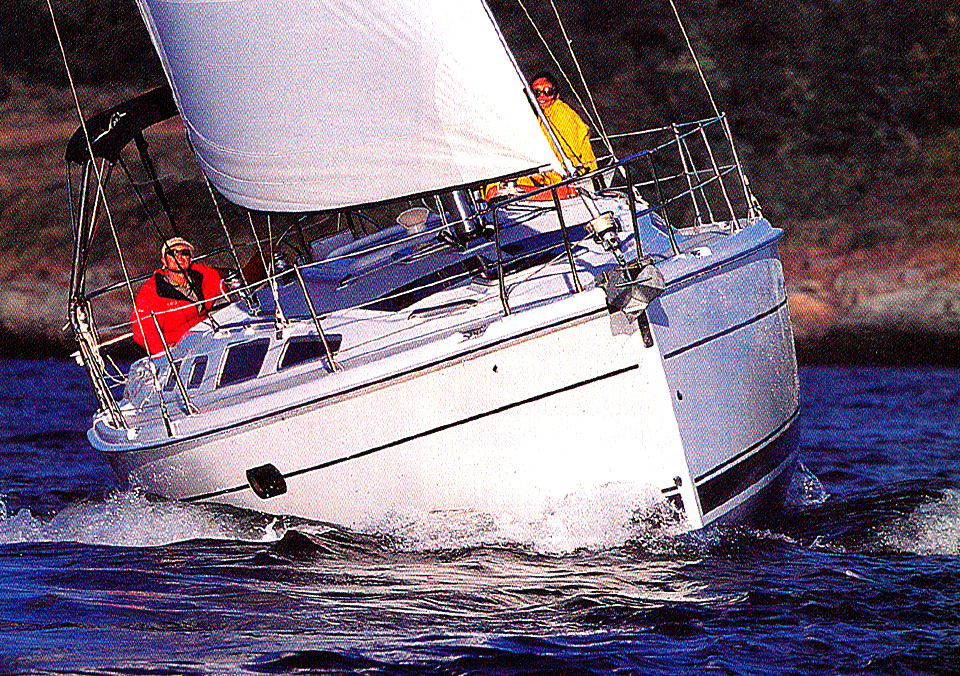
15. Hunter 356
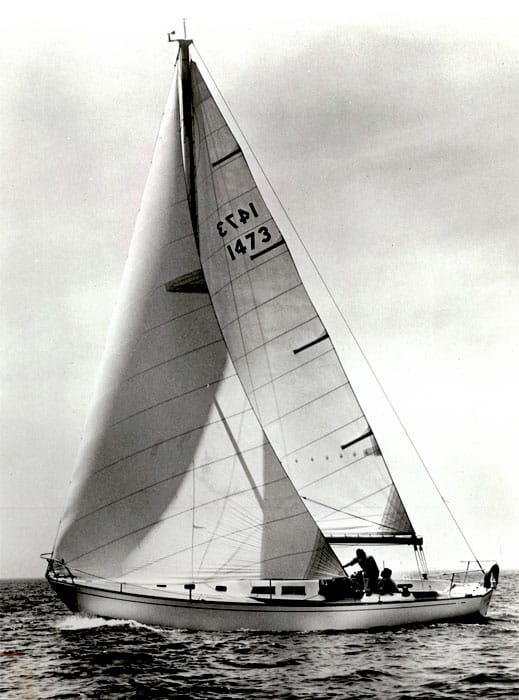
13. Beneteau 423
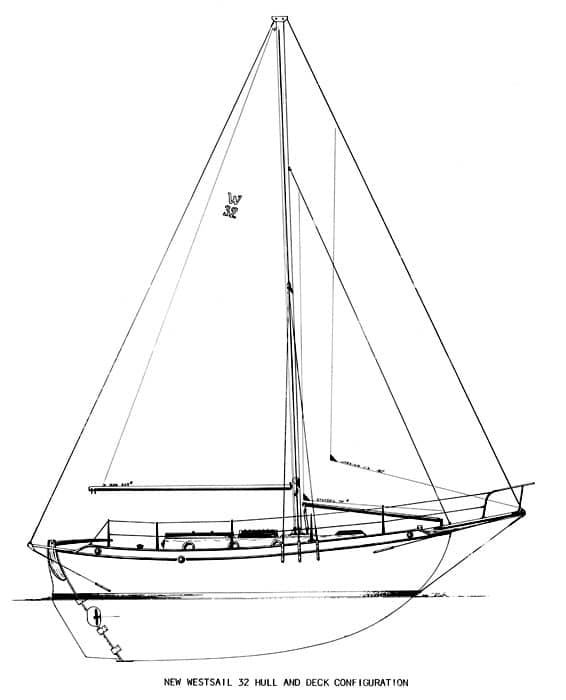
12. Westsail 32
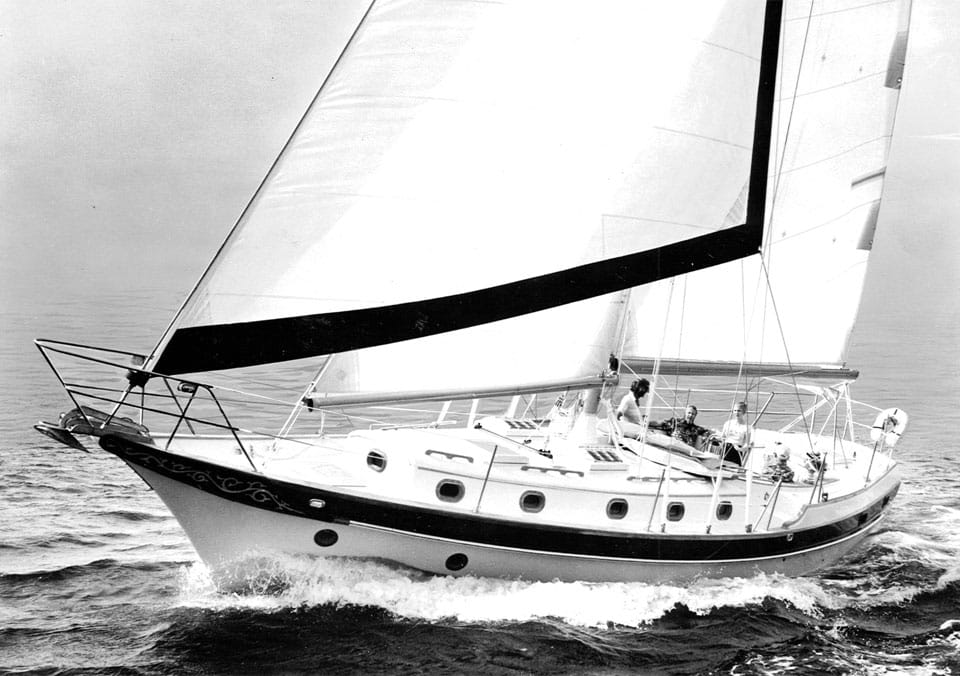
– CHECK THE WEATHER – The weather changes all the time. Always check the forecast and prepare for the worst case. Safety Tip Provided by the U.S. Coast Guard
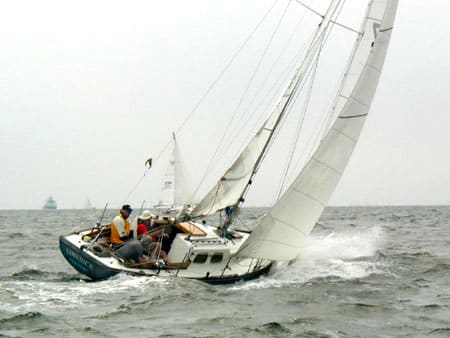
10. Alberg 30
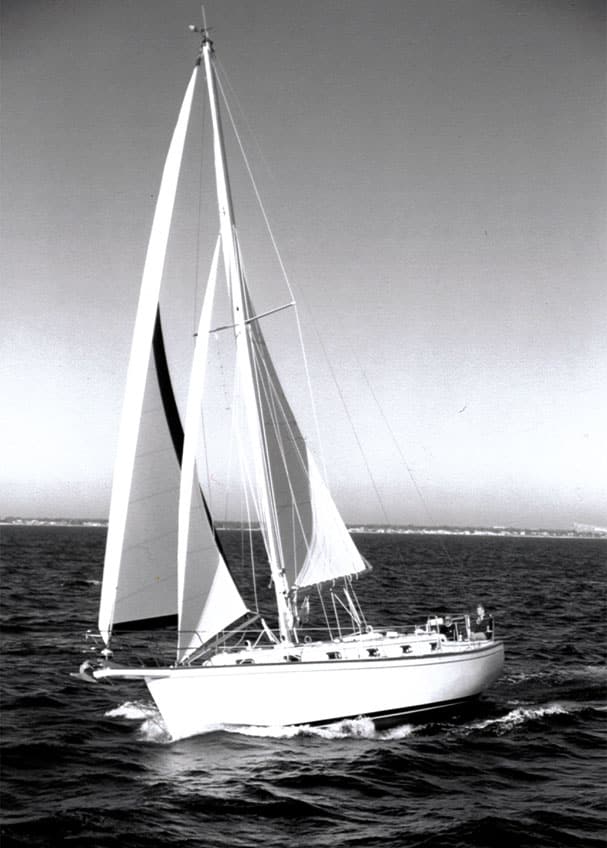
9. Island Packet 38
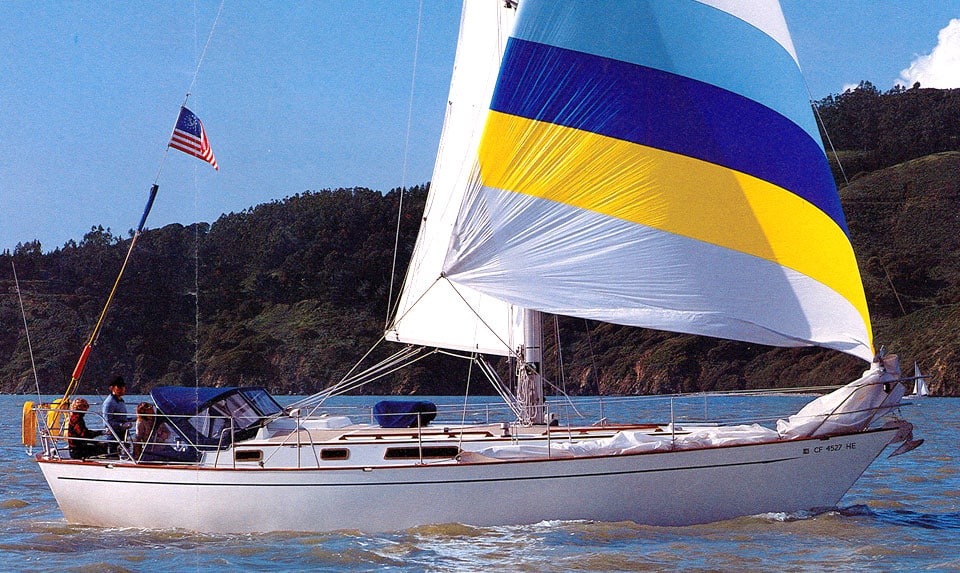
8. Passport 40
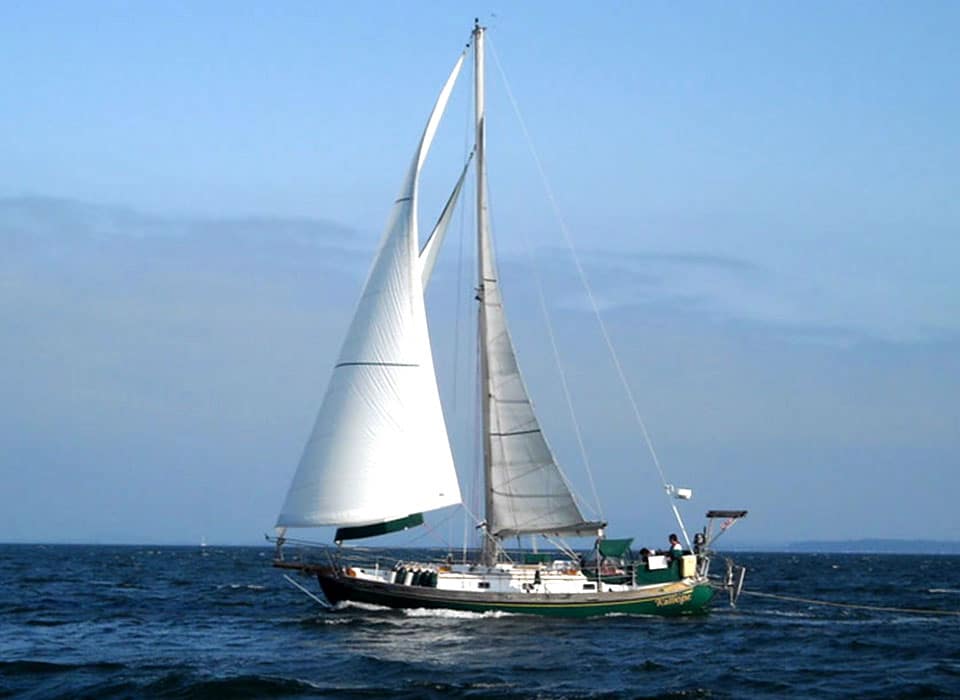
7. Tayana 37
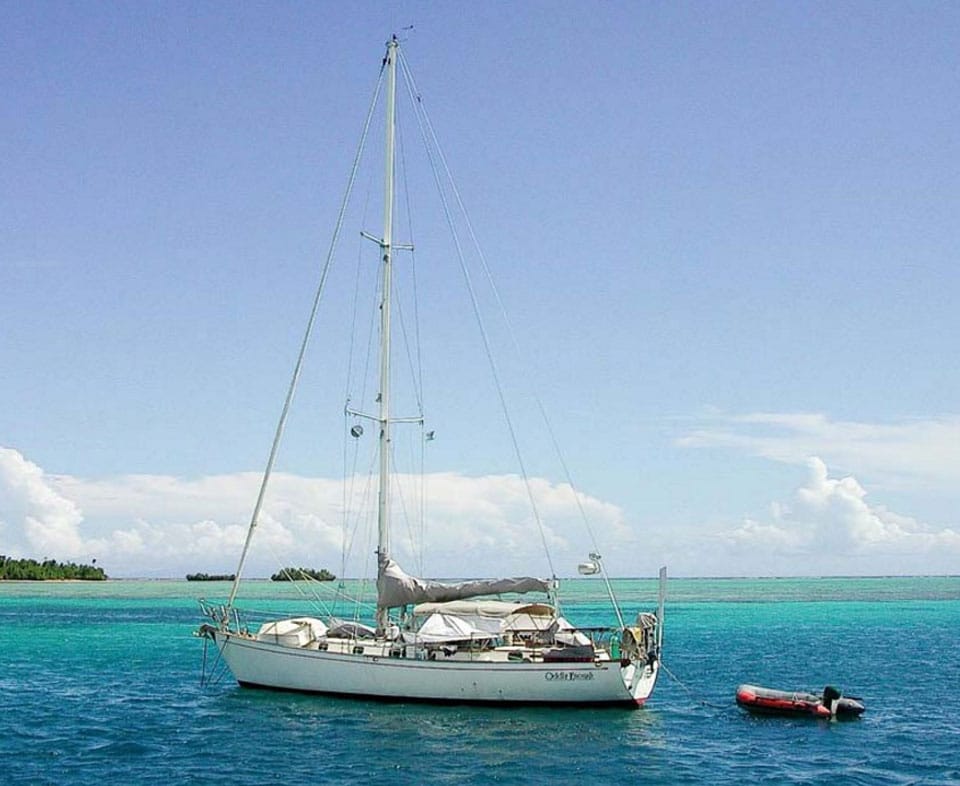
6. Peterson 44
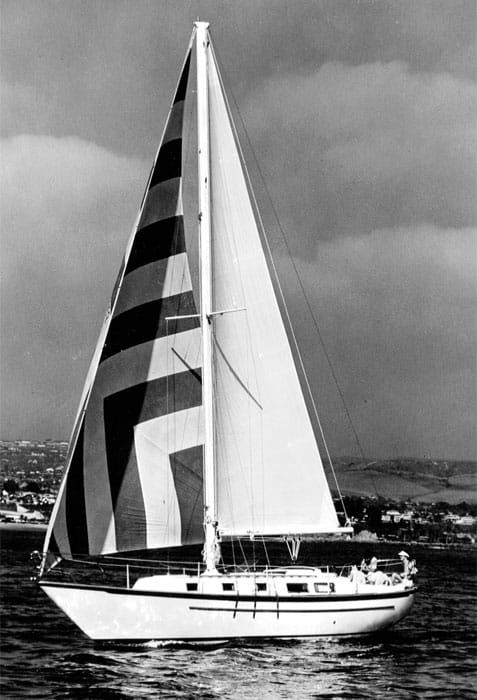
5. Pacific Seacraft 37
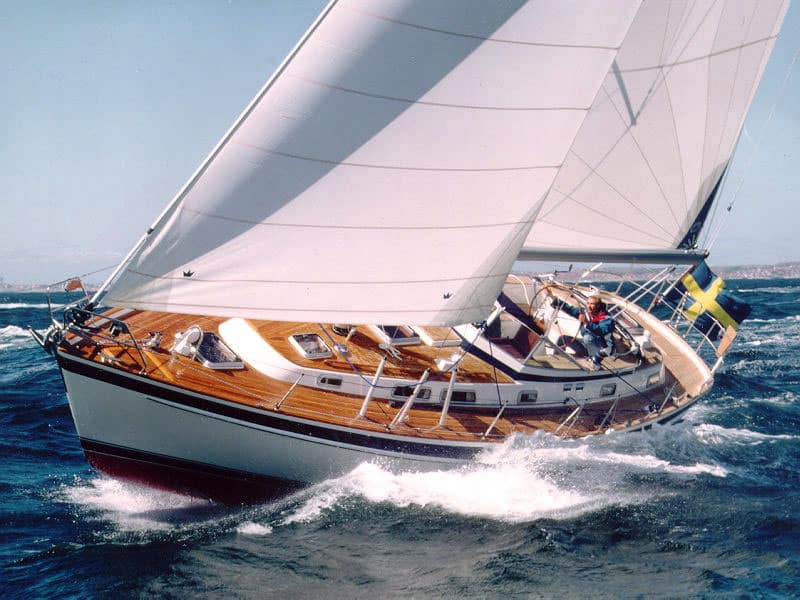
4. Hallberg-Rassy 42
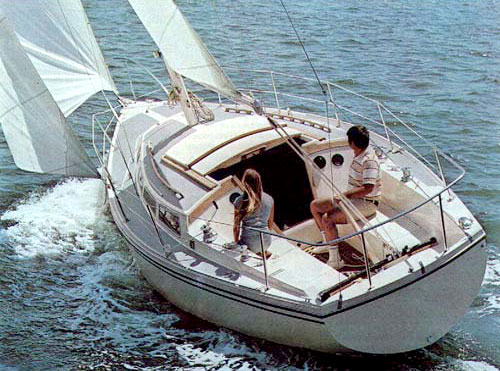
3. Catalina 30
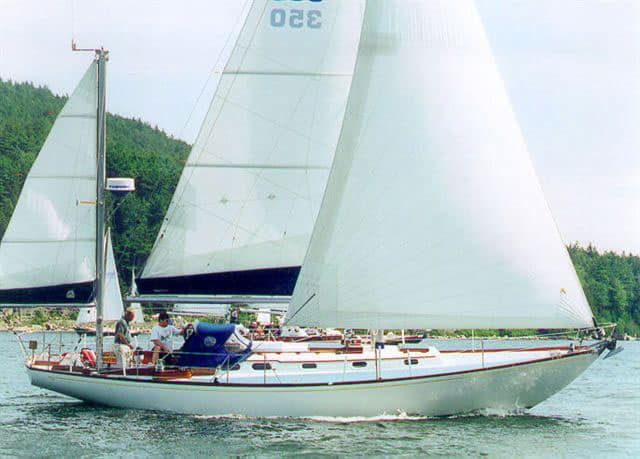
2. Hinckley Bermuda 40
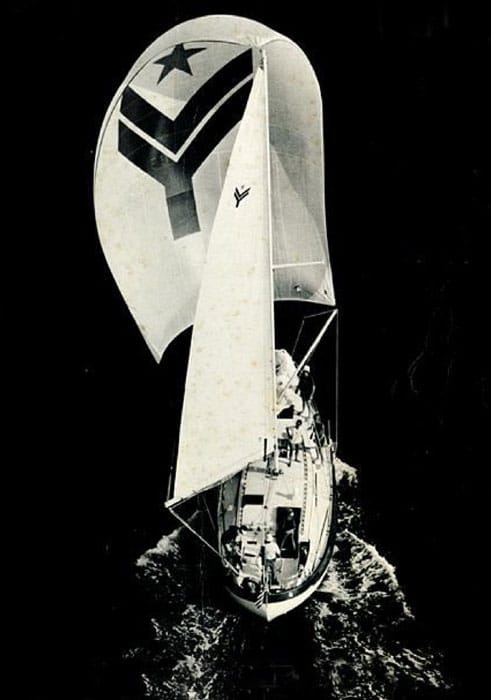
1. Valiant 40
- More: monohull , Sailboats
- More Sailboats
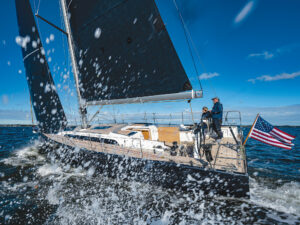
Sailboat Review: Solaris 44
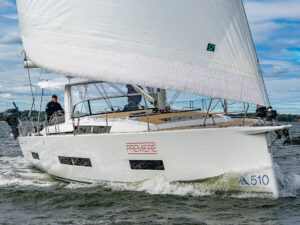
Sailboat Review: Hanse 510
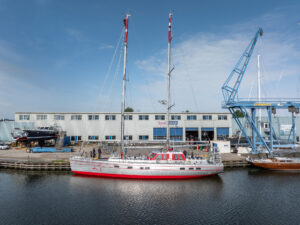
The Pelagic 77 Amundsen is Delivered
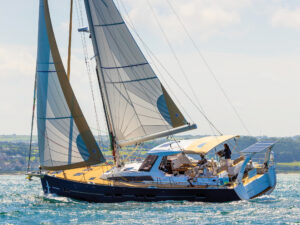
New Boats on Deck

The Ship’s Library: Add These Essential Reads for Caribbean Cruising
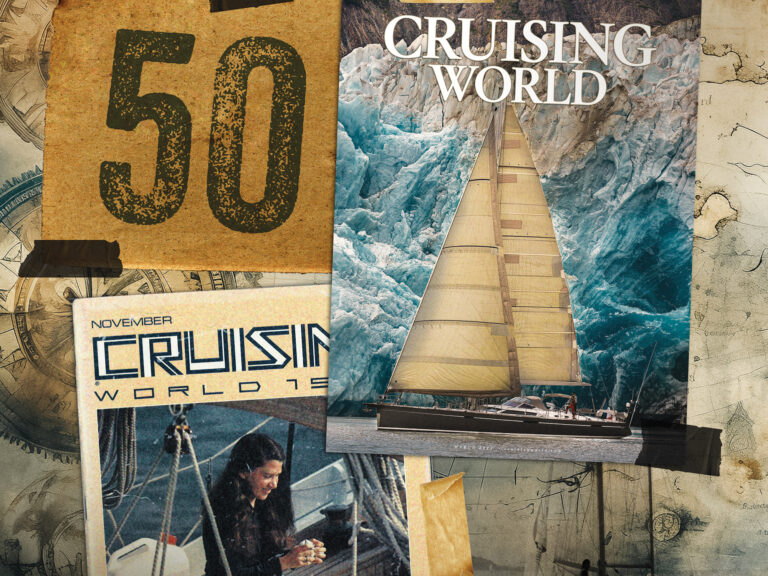
Gold Standard: Cruising World Turns 50
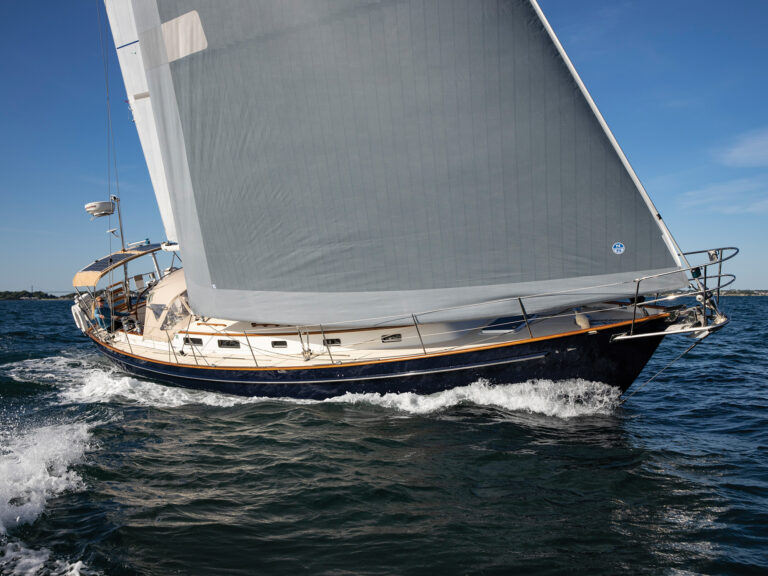
More, Please: Life After Six Months at Sea
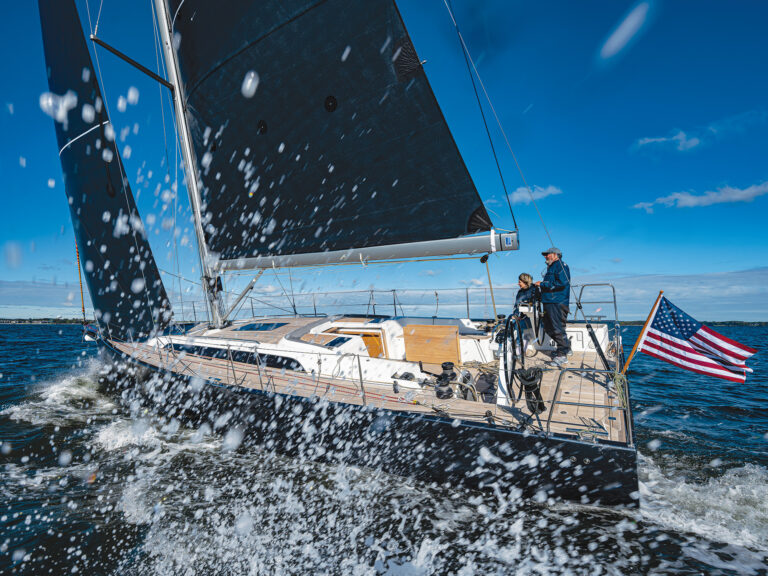
- Digital Edition
- Customer Service
- Privacy Policy
- Terms of Use
- Email Newsletters
- Cruising World
- Sailing World
- Salt Water Sportsman
- Sport Fishing
- Wakeboarding
- New Sailboats
- Sailboats 21-30ft
- Sailboats 31-35ft
- Sailboats 36-40ft
- Sailboats Over 40ft
- Sailboats Under 21feet
- used_sailboats
- Apps and Computer Programs
- Communications
- Fishfinders
- Handheld Electronics
- Plotters MFDS Rradar
- Wind, Speed & Depth Instruments
- Anchoring Mooring
- Running Rigging
- Sails Canvas
- Standing Rigging
- Diesel Engines
- Off Grid Energy
- Cleaning Waxing
- DIY Projects
- Repair, Tools & Materials
- Spare Parts
- Tools & Gadgets
- Cabin Comfort
- Ventilation
- Footwear Apparel
- Foul Weather Gear
- Mailport & PS Advisor
- Inside Practical Sailor Blog
- Activate My Web Access
- Reset Password
- Customer Service

- Free Newsletter

Catalina 320 Used Boat Review
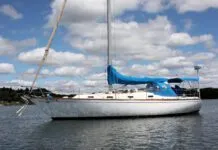
Tartan 37 Used Boat Review

C&C 33 Mark II Used Boat Review
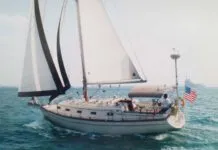
Island Packet 350 Used Boat Review
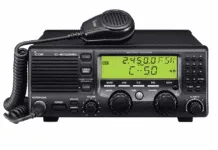
How to Create a Bullet-Proof VHF/SSB Backup

Tips From A First “Sail” on the ICW

Tillerpilot Tips and Safety Cautions

Best Crimpers and Strippers for Fixing Marine Electrical Connectors
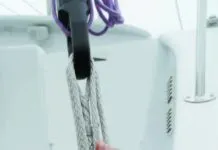
Lashing for Strength
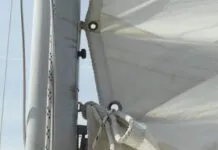
Are Wrinkles Killing Your Sail Shape?

Superlight Anchors: Not Just for Racers
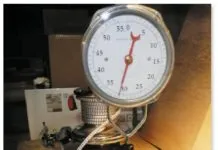
Refining Furling Line Fairleads
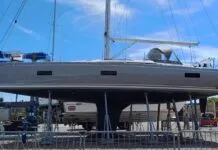
Keel and Rudder Design Basics

Diesel-Electric Hybrids Vs. Electric: Sailing’s Auxiliary Power Future

Sailing Triteia: Budget Bluewater Cruising

How To Keep Pipe Fittings Dry: Sealant and Teflon Tape Tests

How Much Does it Cost to Own a Sailboat in Quebec,…

Anode Basics: Dos and Don’ts

What’s The Best Bottom Paint?
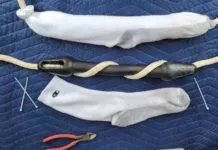
Boat Hook and Fender Hacks

PS Advisor: Acid Cleaning Potable Water Systems

Product Hacks: Velcro, Bounce, Anti-Skid Mats and Pool Lights

Stopping Holding-tank Odors
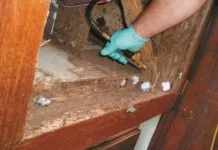
Giving Bugs the Big Goodbye

Cold Weather Clothes to Extend the Sailing Season
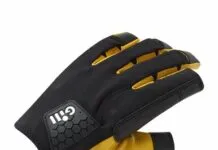
Five Best Gloves: Sailing and DIYing in All Weather
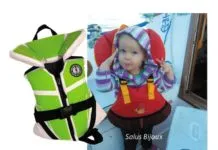
Sailing Gear for Kids
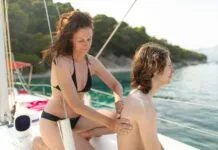
What’s the Best Sunscreen?

Boats That Fly? How High Tech Rocked the America’s Cup

R. Tucker Thompson Tall Ship Youth Voyage

On Watch: This 60-Year-Old Hinckley Pilot 35 is Also a Working…
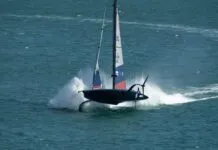
On Watch: America’s Cup
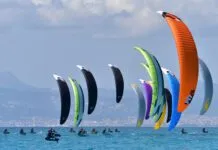
On Watch: All Eyes on Europe Sail Racing
- Sailboat Reviews
Comfortable Sailboat Cockpit Seating
Man is the measure of all things, wrote pythagoras, and that is nowhere more true than in the cockpit of a sailboat. heres a look at what makes a seat comfortable, and how a variety of production boats measure up..
The proportions of the human body are the basis of all design. Cockpit seating, as with any seat or chair design, is one of the most complicated problems facing the designer. Niels Diffrient, an industrial designer and one of the worlds leading authorities on aircraft seating, says that, Chair design is the acid test for designers.
If youre a typical sailor, it has been estimated that you spend most of your valuable and limited time on the water in the cockpit.
Cockpit seating and layouts on sailboats need not only accommodate a wide range of body types, but also conflicting task requirements including steering, sail trimming, navigating, sitting while eating, lounging while socializing or reading and perhaps sleeping both at anchor and heeled 20 to 30.
The amount of clothing worn also can have a considerable impact on seat function and comfort. Non-skid can be quite uncomfortable while wearing bathing suits or other thin clothing. Likewise, in cold conditions multiple bulky layers of clothing can substantially change your bodys proportions, requiring different seat dimensions. Seats may also have to function with and without cockpit cushions, which will additionally alter their dimensions and comfort.
Aesthetic considerations must be considered, too. Unfortunately, this often means that coaming/seatback heights are lower than ideal. Given the many variables, tasks and body types to take into consideration, one begins to understand the true complexity of this design problem.
Assessing a comfortable seat is a more complex problem than it may seem. Rarely is a seat that seems comfortable initially, ideal in its support for long-term comfort. Its no accident that the best of todays firm and contoured office chairs, including those from Herman Miller and the late Sunar Hauserman that are designed for eight hours of continuous use, have very little in common with the often poorly designed soft couches and chairs commonly found in the home.
Because sailboats are constantly in motion, round corners are the first step toward a well-designed cockpit. Round corners are easier on the body, inherently stronger and are more durable over time.
All vessels work or flex in a seaway to a certain extent. These stresses become concentrated in sharp corners into what is known as the hinge effect. Although it is rare, if a vessel sees enough stress cycles, sharp corners can weaken and potentially fail. Round corners are also easier than sharp corners to build in fiberglass. So why are sharp corners seen so often? Usually its a matter of the designer wanting a crisp look or style; its also somewhat easier to produce tooling with sharp corners although the gain is more than offset by the difficulty later of laying-up the fiberglass cloth into these corners on the mold without creating voids.
Cockpit seats should be 6′ 2″ to 6′ 6″ long to allow three people to sit side by side, or one person to sleep in relative comfort.
The cockpit seat faces (or footwell area) should not be much more than about 28″ to 30″ apart or you may not be able to brace your feet when heeled. The minimum footwell width is 24″. Footwells less than 27″ wide, however, do not allow people to comfortably sit directly opposing each other. Cockpits with permanently mounted cockpit tables can be wider as the table structure provides foot bracing. The seating area forward of the table, adjacent to the companionway, is often a problem as neither the table nor the opposite seat provides a foot brace.
According to Niels Diffrient, seat lengths less than 13″ do not give adequate seat support under the thighs, the load on other tissues is consequently increased and the resulting discomfort is reflected in shorter sitting times. Seat lengths greater than 16″, however, do not accommodate the small person as the front edge of the seat comes in contact with the back of the leg, forcing him or her to sit toward the front or to slide forward away from the backrest support, resulting in poor posture. Diffrients research points out that if the seat comes too far forward it will put pressure on the bottom of your thigh at the point where there is a nerve that crosses under the thigh over a bundle of muscles. Pressure on this nerve over a period of time can cause your foot and leg to go to sleep. For long-term comfort there should be a gap of about 2″ between the seat edge and the back of your lower leg.
The front of a seat should be rounded with a minimum radii of 1″ to 2″ to further reduce tissue pressure. In a well-designed seat the sitter should not be aware of the front edge of the seat. The rounded seat edge is also easier on the feet when the leeward seat is used as a foot brace while going upwind.
A fixed seat height of 17″ accommodates the largest number of adults, while seats lower than 15″ are hard to get up from. Seat flat angles from about 1-1/2 to perhaps 8 would be appropriate for cockpit seating.
An angle of about 3 is desirable from the front edge of the seat down to foot level, as an assist in rising. This feature, unfortunately, is not seen very often in fiberglass boats as it requires a more complex and therefore costly two-part mold.
Correctly contoured seats and seatbacks (on which much study has been done, and an abundance of information is available) are the ideal in terms of long-term sitting comfort. Seat flats with as little as 1/2″ curve toward the rear of the seat can substantially increase long-term sitting comfort and security while still allowing the seat to be walked on and slept on.
A backrest that does not maintain the natural curvature of the hollow of the back (the lumbar region) may induce backaches. Backrests under 15″ high are too short for relaxation comfort. Backrest-to-seat angles of 95 to 120 are recommended.
Because cockpit seating is not as task specific as chair design, the above dimensions derived from Diffrients research are, we believe, somewhat on the small size.
Diffrients own research backs up our intuitions.
Anthropometry is the measure of humans. Anthropometric data is largely gathered by governments for military purposes and clothing sizing. This data has, we think, some rather surprising findings. We all are aware that the average persons height in the US is increasing, but you may not realize that people on the West Coast average an inch taller than people in the east! or that offspring of wealthy families are taller than average by more than an inch. This leaves designers in something of a quandry, trying to figure just who they are designing for. Certainly, tall people have a poorer selection when it comes to choosing a boat with adequate headroom, leg room and berth lengths.
We believe seats should be about 17″ or 18″ from the sole and about 17″ to 20″ wide. The wider seat dimension would accommodate backrest cushions and sleeping. If this data seems politically incorrect somehow, it must be kept in mind that by accommodating the average size adult as opposed to the average size sailor you are still comfortably fitting only 50% to 60% of todays overall adult population.
Seat cushions are largely a matter of preference, the potential for added comfort must be weighed against their effect on seat geometry and difficulty in stowage when not in use. They may also require fiddles to keep them in place, making sitting uncomfortable when the cushions are not in use.
Perhaps the best argument for the use of cushions is shock and vibration. When you initially sit down, or as the boat falls off a wave, the shock compresses the discs in your back, leading to strain in your lower back.
Long periods of time are also often spent motoring or with a generator operating; vibration-sensitive people can become ill as a result of vibration.
For maximum long-term comfort, seat cushions need not be more than about 2″ thick. Construction should be comprised of 1-1/2″ medium foam padding glued on top of 1/2″ firm, closed-cell foam. Seat covering material should not be coarse or slippery, but should breathe, resist mildew and have UV protection. Marine acrylics do a good job.
As for color, a non-reflective light gray is the best choice for cushion coverings, for the same reasons light gray non-skid is popular (i.e., it has low reflectance, stays relatively cool and is psychologically neutral). If you find gray too boring, a neutral green or blue green is also a good choice. Green, not only low in reflectance, has been found to have a calming psychological effect and isn’t that why many of us go sailing in the first place?
RELATED ARTICLES MORE FROM AUTHOR
Great article! The products in this review may have made I realize that there are several choices of boat seat. Since I’ve learned a lot from various items, I now can invest in the best boat seats for me and my boat.
LEAVE A REPLY Cancel reply
Log in to leave a comment
Latest Videos
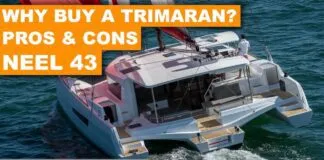
Why Buy a Trimaran? Pros and Cons of Trimarans – NEEL...

The CLAIMED Best Anchor in the World! Ultra vs Rocna vs...

J Boats J/9 Sailboat Review and Boat Tour

3 Tips for a Dry Boat – DIY Boat Maintenance 101
Latest sailboat review.
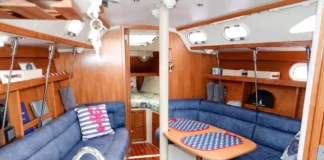
- Privacy Policy
- Do Not Sell My Personal Information
- Online Account Activation
- Privacy Manager

A Breakdown of the Different Types of Sailboats and Their Uses
Updated: Jan 8
To the untrained eye, all sailboats are pretty much the same (some are just bigger than others). They’re essentially floating vessels with a mast, a set of sails, and the ability to navigate the waters by harnessing wind power. But if you dive a bit deeper, you’ll see there are drastic differences in the designs, capabilities, and uses of each type of sailboat.
Whether you’re new to sailboats or already an American Sailing Association (ASA) certified skipper, knowing the difference between the different types of vessels is essential. We’ll provide you with a basic understanding of the different types of sailboats, the advantages of each, and which type of voyage they’re best used for.
Sailboat Rigging Types
When you start sailing, one of the first things you’ll notice is how complicated the rigging seems. The rigging system includes ropes, furling jibs, booms, winches, cables, chains, masts, and much more. It takes time to identify and understand each one, but each type of sailboat has a distinct rigging system. A few of the main types of rigging you can expect to see on the water include:
Sloop: The sloop is arguably the most common rigging system. With one mast and two sails (mainsail & headsail), this type of rigging is simple, but efficient and prepared for all types of situations.
Cutter: If you squint, you could easily mistake a cutter for a slope, but there are slight differences. A cutter has a smaller headsail and an additional staysail between the mast and forestay of the vessel. The extra sail allows for more stability and control in heavy winds.
Ketch and Yawl: Both the ketch and yawl rigging types have two masts. However, what makes them different is in a ketch rigging, the aft mast (mizzen) is taller than the one on a yawl. Also, it’s positioned in front of the rudder post. These riggings are known for their excellent balance and flexibility in most conditions.
Schooner: If you have ever toured older wooden ships built to sail around the world and explore the ocean, then you have probably been aboard a Schooner. This configuration can have two or more masts and the aft mast is taller than the forward one(s). These vessels are powerful and equipped for the long haul.
Types of Sailboats and Their Uses
There are many types of sailboats (not to be confused with rigging types), each with its own pros, cons, and uses. Here’s a look at five of the most popular sailboats and why sailors use them.

When most people think of sailboats, they think of sailing dinghies. These small sailboats are less than 15-feet long and can be sailed by one person or a small crew. In most cases, they have small sloop rigs, are monohulls, and are excellent as a first sailboat. Dinghies are also great for racing or using as a lifeboat for bigger vessels.
Pros of a dinghy: Easily managed, relatively inexpensive, and great for beginners.
Cons of a dinghy: Not much space, only designed for short trips, and not recommended for rough waters or harsh weather conditions.

A daysailer is like the dinghy’s older brother. It’s usually about 14-20 feet in length and sloop-rigged. As the name suggests, they’re best for day trips on the ocean. In most cases, daysailers have a small cabin or open cockpit. They’re designed more for fun rather than long distances.
Pros of daysailers: Easy handling, stable, and great for outings with family or friends.
Cons of daysailers: Assmaller boats, they aren’t designed for overnight trips or long voyages.

The catamaran is where luxury on the sea begins. Its two parallel and equal-sized hulls make the vessel much more stable and comfortable than its single-hull counterparts. It’s a highly customizable boat that can be small and sporty or large and luxurious, depending on your needs.
More experienced sailors use these types of sailboats for longer trips and smaller charter trips .
Pros of the catamaran: A lot of space, fast, and perfect for cruising at sea.
Cons of the catamaran: Since they have such a wide beam, it can be a challenge to find places to dock or maneuver in tight marinas.

If you’re drawn to the size and stability of the catamaran, but yearn for more speed and power then you’ll love the trimaran. Instead of two hulls, this bigger boat has three: a main hull in the middle, and two smaller outrigger hulls on its sides. It’s an excellent sailboat for racing and cruising due to its stability and speed.
Pros of trimarans: Ability to be very fast, stable, and less likely to capsize in rough waters than smaller sailboats.
Cons of trimarans: They’re larger boats, so it can be difficult and more expensive to dock or store them in certain places.
Cruising Keelboat

Suppose you want to take an overnight cruise or even a trip across the Atlantic Ocean. In that case, a cruiser is your best bet. These large-sized sailboats (usually more than 30 feet long) are designed to be comfortable and self-sufficient, which makes them ideal for long voyages.
Pros of Cruising Keelboats: Well-suited to go on long-distance cruises for weeks or months with the ability to support multiple passengers.
Cons of Cruising Keelboats: You’ll not only have to invest in the sailboat (including storage and upkeep), but it also requires a large crew and an experienced captain.
Frequently Asked Questions (FAQs) About Sailboat Types
What is the most common type of sailboat.
Sloop-rigged sailboats (particularly daysailers and dinghies) are among the most popular types of sailboats. However, generally, the most commonly used sailboat depends on who’s using it. For example, a racer will have much different needs than someone who just wants the right boat for cruising.
What’s the difference between a sailboat and a yacht?
In the U.S., the determination between a sailboat and a yacht is that a sailboat only uses wind power, while a yacht can use wind, a motor, or a combination of both. However, internationally, sailboats and all other boats are usually considered “yachts.” Size can also be a determining factor. For example, some people consider any boat longer than 40 feet to be a yacht.
What’s the best beginner sailboat?
If you don’t have any sailing experience , the best sailboats are usually smaller, easy to maneuver, and less complicated than multihulls. Some of the best small sailboats for beginners have tiller steering and no winches.
This can include vessels like small dinghies, catamarans (though these are multihull boats), rotomolded boats, and those that can be easily trailered to different locations.
What is the safest type of sailboat?
In most cases, larger cruising keelboats are usually considered much safer than smaller dinghies and catamarans. That’s because they’re less likely to capsize and can handle adverse weather more safely, which is especially useful for new sailors. However, sailboat safety depends on the sailor, type of boat, and conditions.
What are the most popular sailboat brands?
There are countless high-quality sailboats on the market. Some of the most popular brands include Beneteau, Jeanneau, Hunter, Catalina, Dufour, Sunfish, Hobie, and many others. These brands have built a reputation of trust and reliability over the years, making them prime choices for new and seasoned sailors alike.
Which type of boat is best for offshore cruising?
If you want to take your sailboat for an offshore cruise, you’ll need something sturdy, reliable, and able to handle harsh sea conditions. In most cases, a cruising keelboat is your best bet for casual offshore cruising as they’re comfortable and self-sufficient vessels. In regards to rigging, ketch, cutter, and schooner rigs are best for sailing offshore because they are adaptable to varying wind speeds.
Learn How to Sail From The Experts
Are you interested in learning more about sailing or getting certified ? First Reef Sailing is one of the top ASA sailing schools in the Boston area.
We can help you learn the basics of sailing so you can get out on the water with confidence. Our certification courses, such as the beginner ASA 101 and ASA 103 courses, will teach you how to sail everything from 20-foot keelboats to 50-foot catamarans.
Take a look at this timeline of how many of our students learn, gain sailing experience, and go on to buy their own sailboats.
Recent Posts
ASA 103 Overview: What to Expect From Basic Coastal Cruising
Acting Fast: What to Do if Someone Falls Overboard
(Article) Tenant Spotlight: First Reef Sailing
Take a look at a quick spotlight about the origins of First Reef Sailing, written by our friends at the Boston Harbor Shipyard and...

IMAGES
VIDEO
COMMENTS
Cockpit design and layout drives many boat-handling tasks, ranging from steering and sail trimming to what goes on when its time to reef. Angles of view can even affect watchkeeping. For example, a high center cockpit and a large overlapping genoa create a 90-degree-plus no see zone, and thats a big deal when it comes to collision avoidance.
The boat is small, but the Catalina 275 still earns points for its spacious cockpit. It’s easier to get a large cockpit on a large boat, but on the opposite end of the big cruising boat spectrum is the sporty Catalina 275. This sailboat builds a clever cockpit into much less space. Designer Gerry Douglas has always understood the importance ...
A centre cockpit deck plan allows the mainsheet to run directly from the end of the boom to the aft deck, with maximum mechanical advantage. The sheet is led from there to the aft end of the cockpit, behind the helm. That’s ideal for shorthanded sailors, as it’s easy for the helmsman to operate, but it is more awkward for another member of ...
The tiller or helm is attached to the rudder and is used to steer the boat. Most smaller sailboats (below 30') have a tiller, most larger sailboats use a helm. Large ocean-going vessels tend to have two helms. Cockpit. The cockpit is the recessed part in the deck where the helmsman sits or stands. It tends to have some benches.
Moderate volume and adequate drainage. For an aft-cockpit boat, the most efficient drainage is through the transom. A couple of 50mm diameter holes here will drain a moderately sized sailboat cockpit inside two minutes; A bridgedeck to at least the height of the seats, which not only reduces the volume of the cockpit well but also provides a ...
30. Swan 44. A strong, robust cruising boat built for high-seas, blue water adventures, the Swan 44 was designed by Sparkman & Stephens, and the yacht’s well-known Finnish manufacturers, Nautor Swan, produced 76 boats in a production run that lasted from 1972-1975.
Cockpit seating and layouts on sailboats need not only accommodate a wide range of body types, but also conflicting task requirements including steering, sail trimming, navigating, sitting while eating, lounging while socializing or reading and perhaps sleeping both at anchor and heeled 20° to 30°.
Cockpit seating and layouts on sailboats need not only accommodate a wide range of body types, but also conflicting task requirements including steering, sail trimming, navigating, sitting while eating, lounging while socializing or reading and perhaps sleeping both at anchor and heeled 20 to 30.
There are countless high-quality sailboats on the market. Some of the most popular brands include Beneteau, Jeanneau, Hunter, Catalina, Dufour, Sunfish, Hobie, and many others. These brands have built a reputation of trust and reliability over the years, making them prime choices for new and seasoned sailors alike.
Ketches. Ketch rigs feature two masts, with the taller one forward. Photo via Knot 10 Yacht Sales. A ketch is another type of rigging and refers to a sailboat which has two masts, the forward mast being taller than the aft one. Ketch rigs are favored for being easy to handle and tracking well in a breeze.